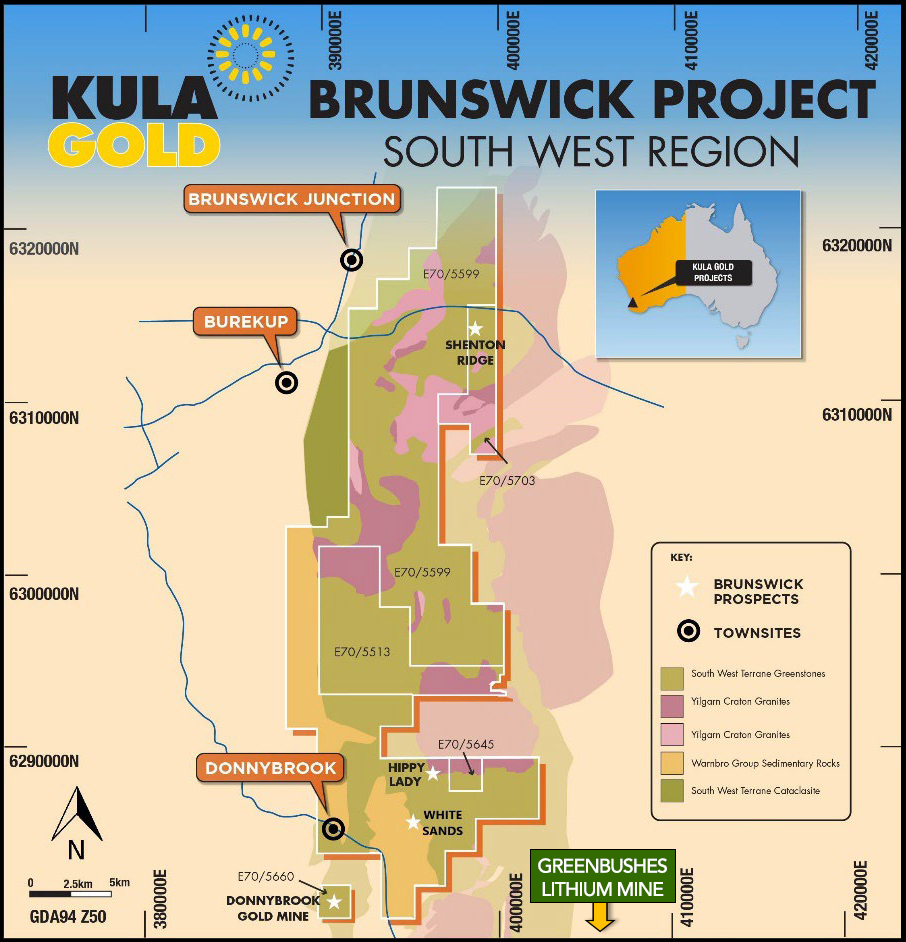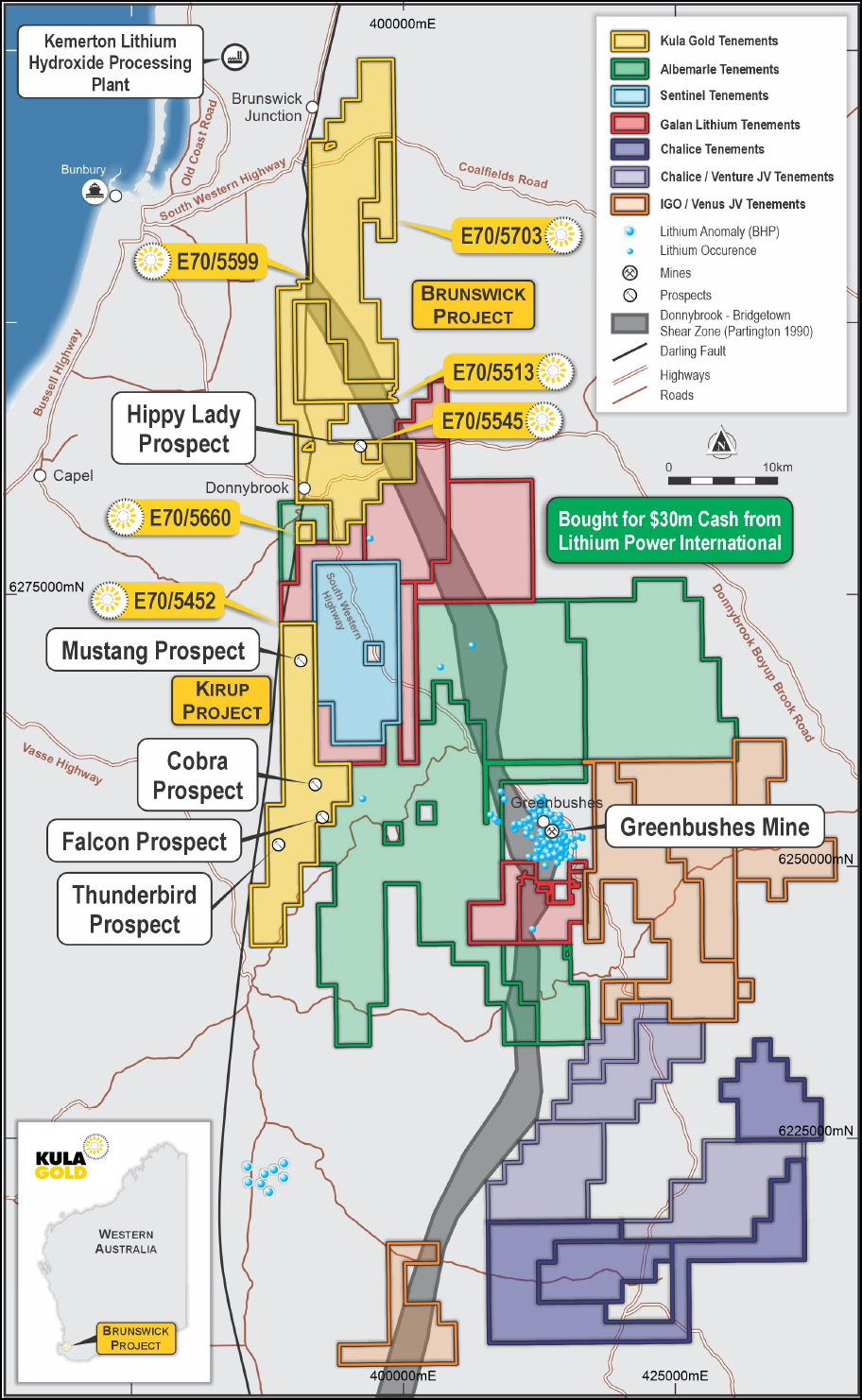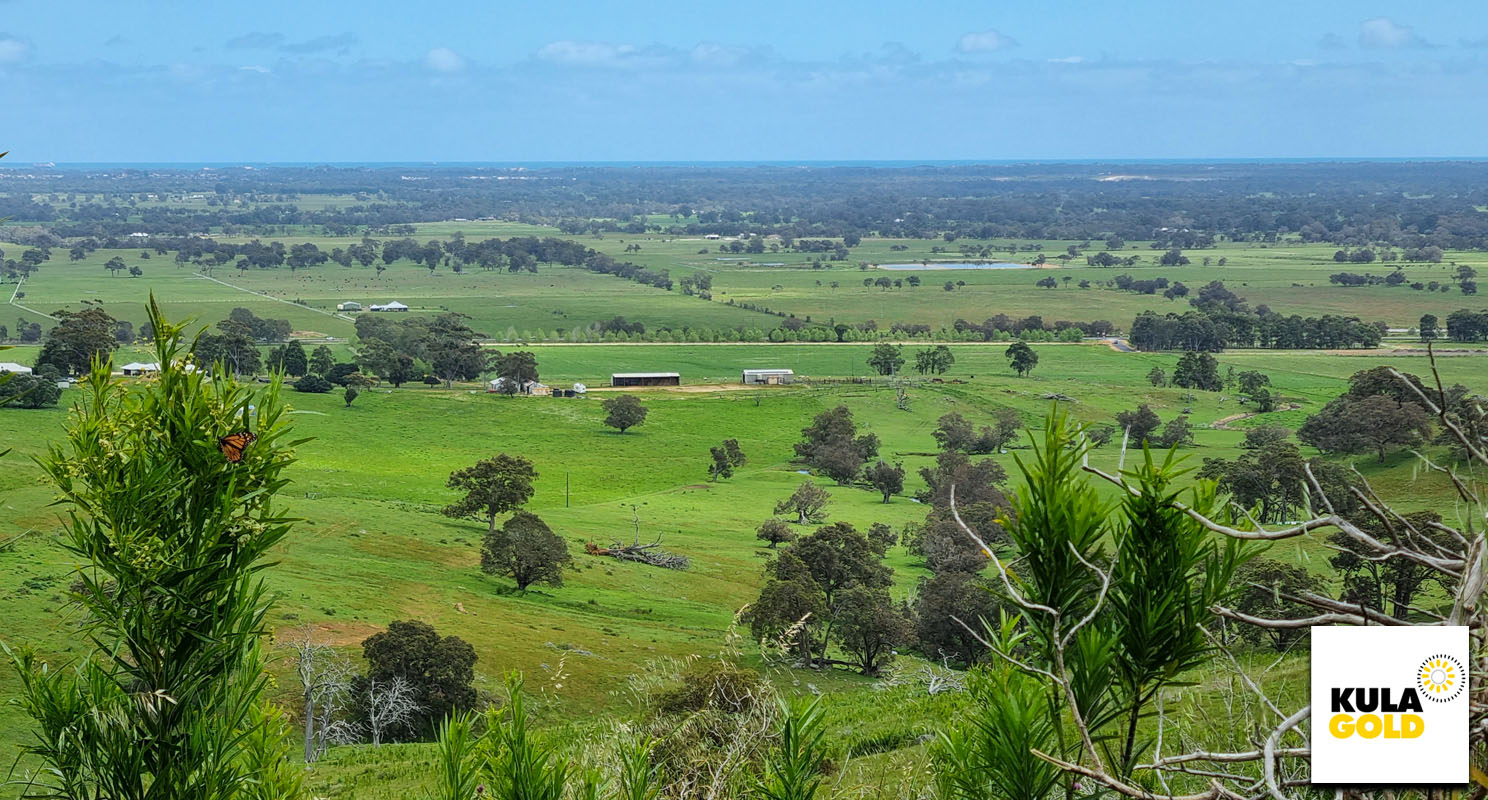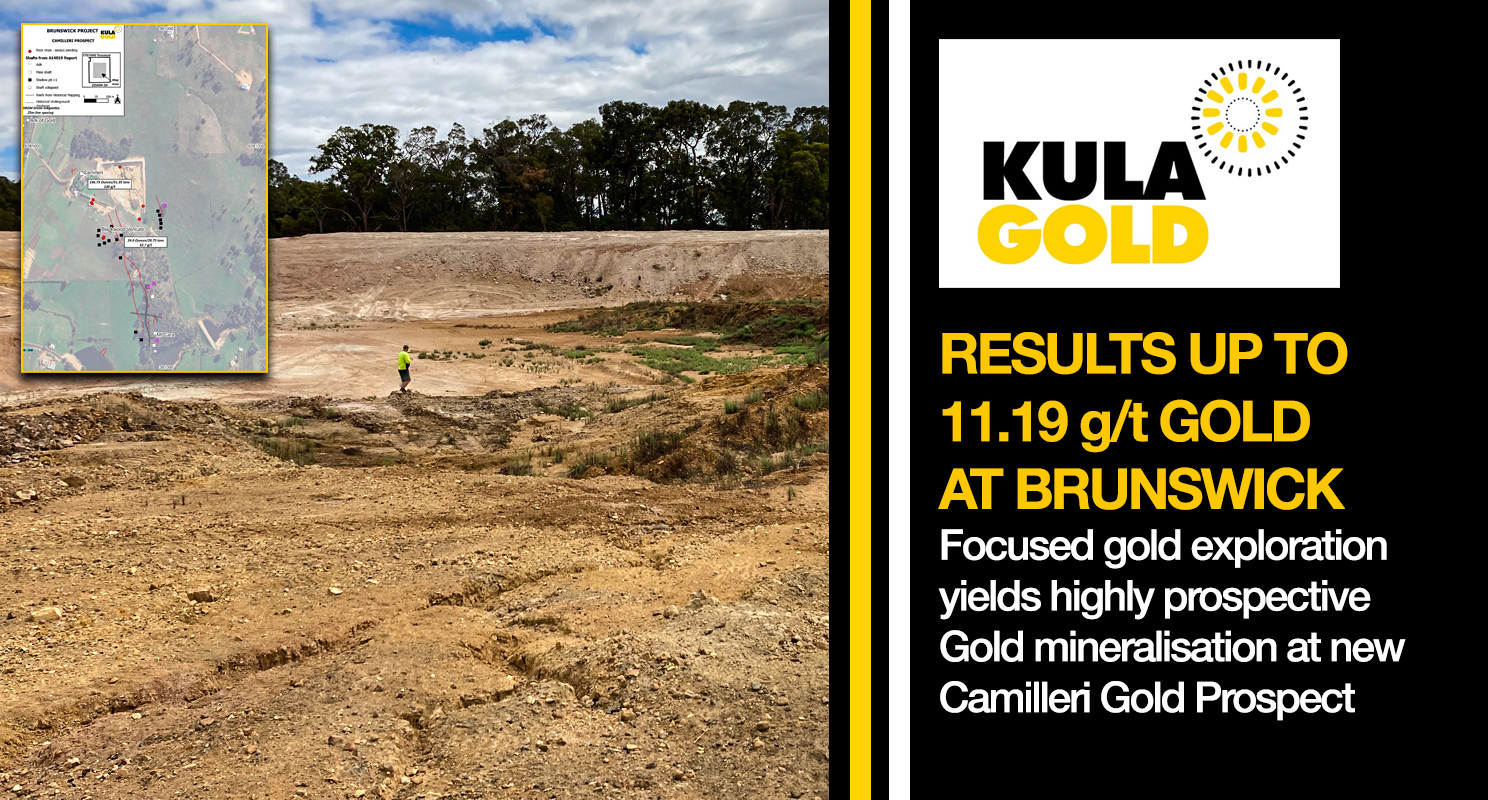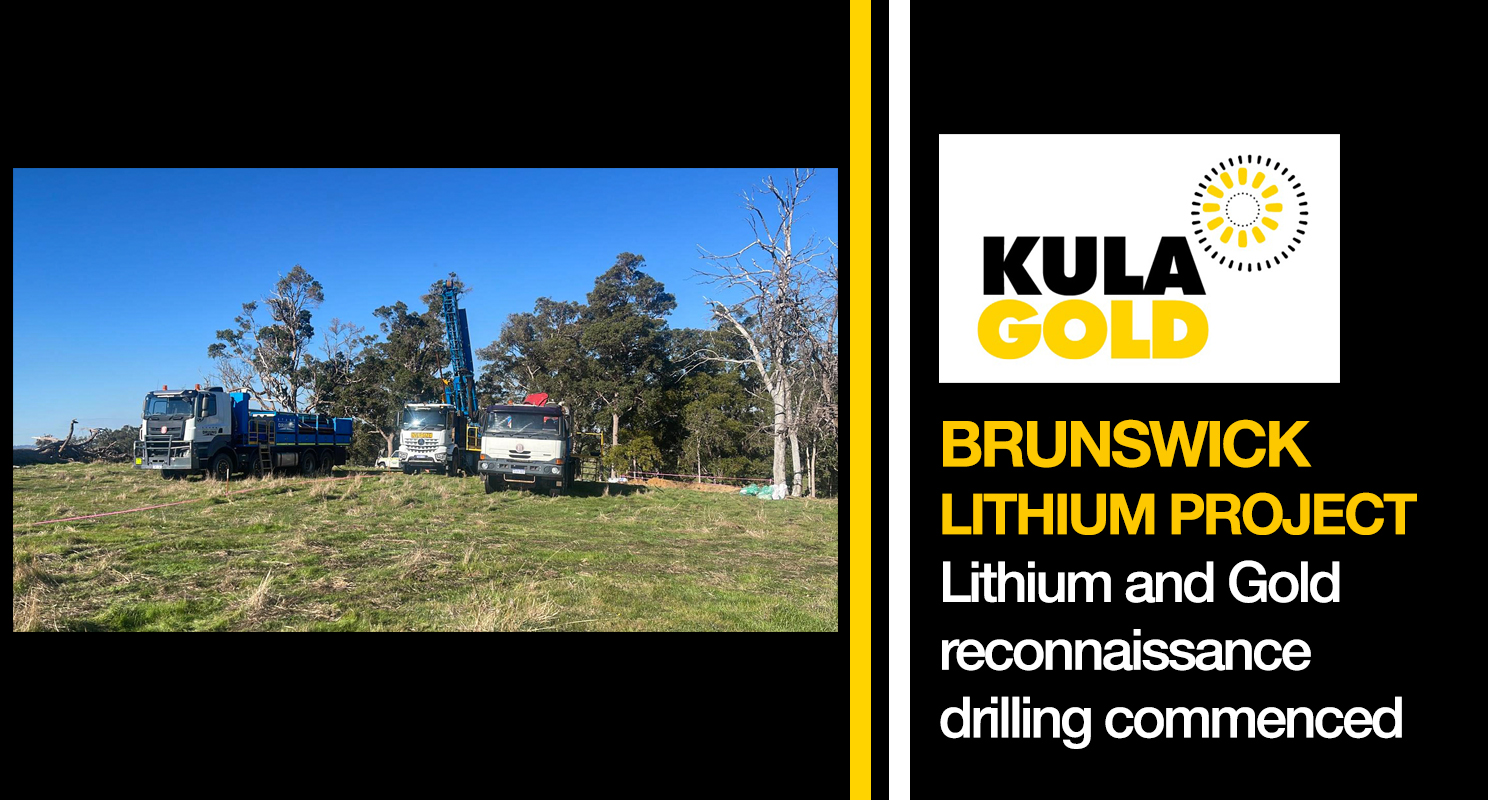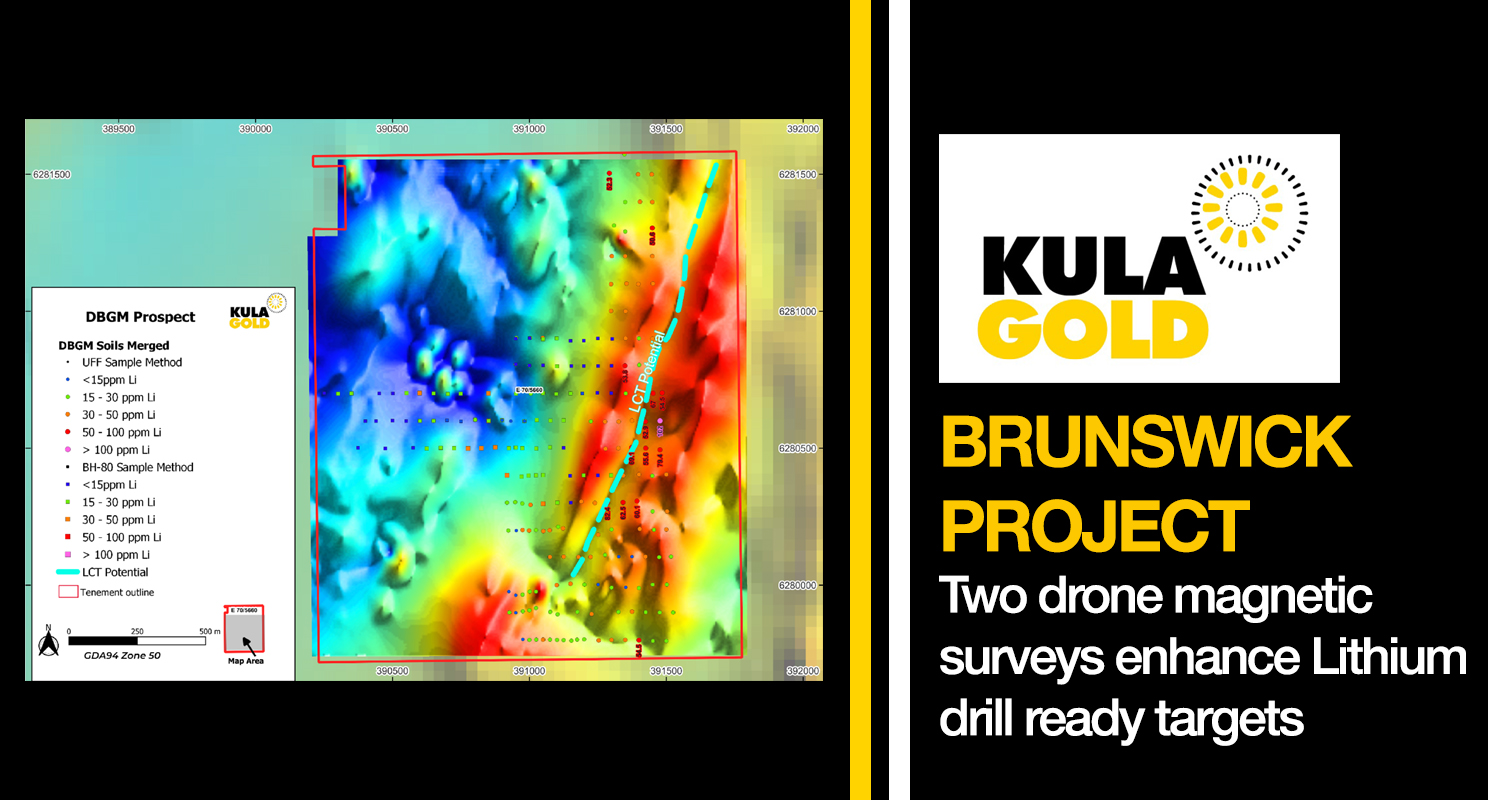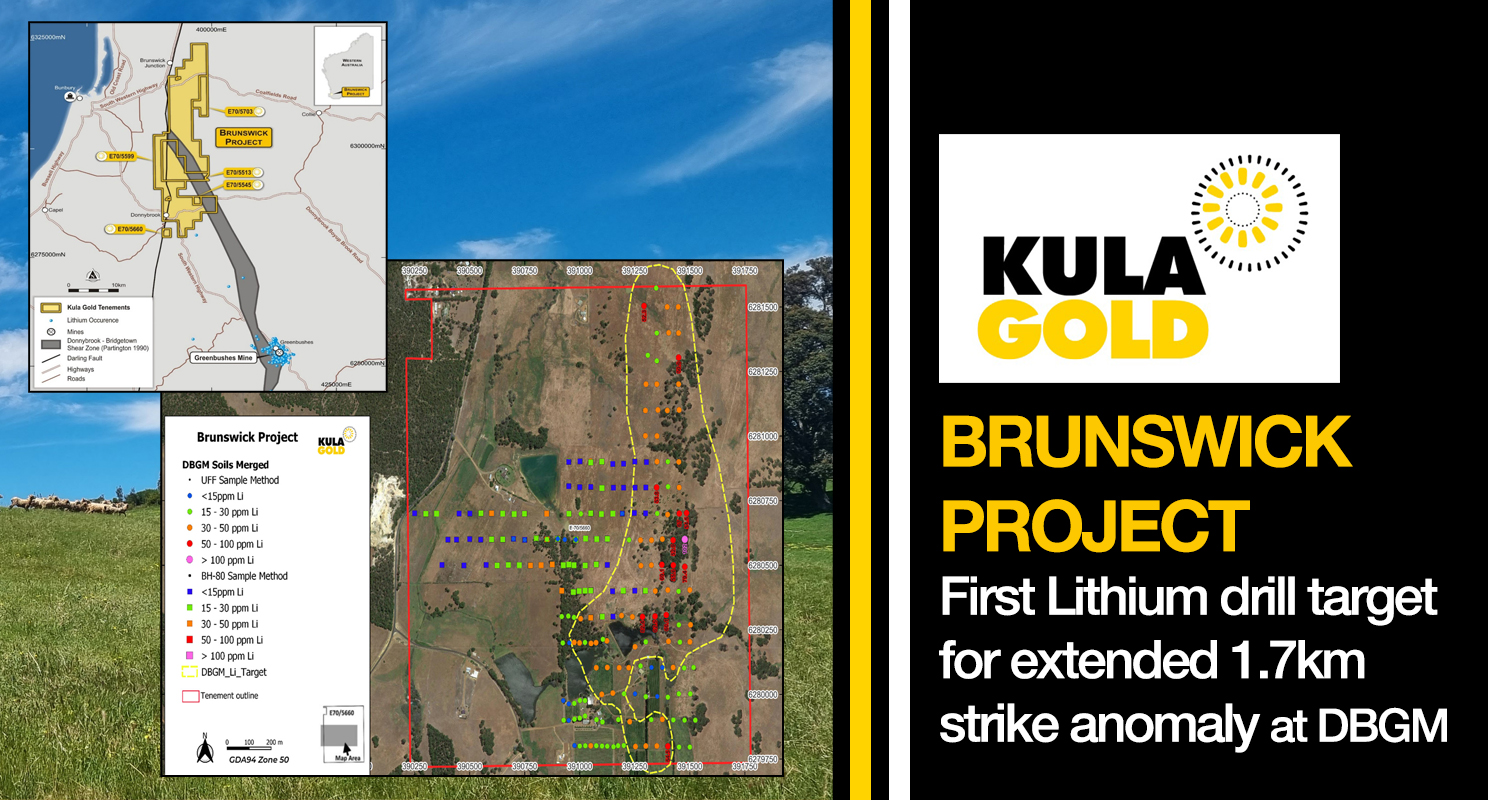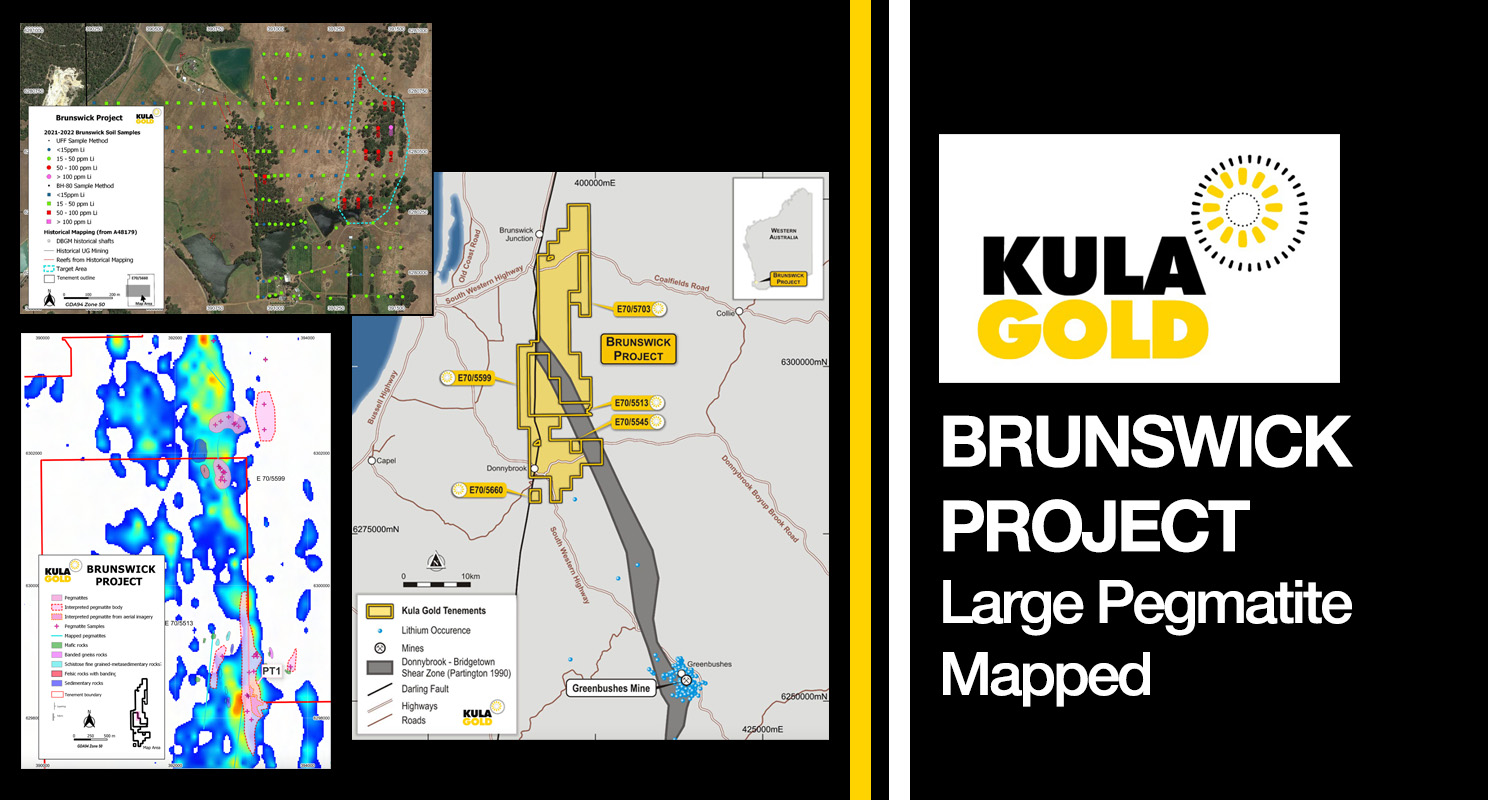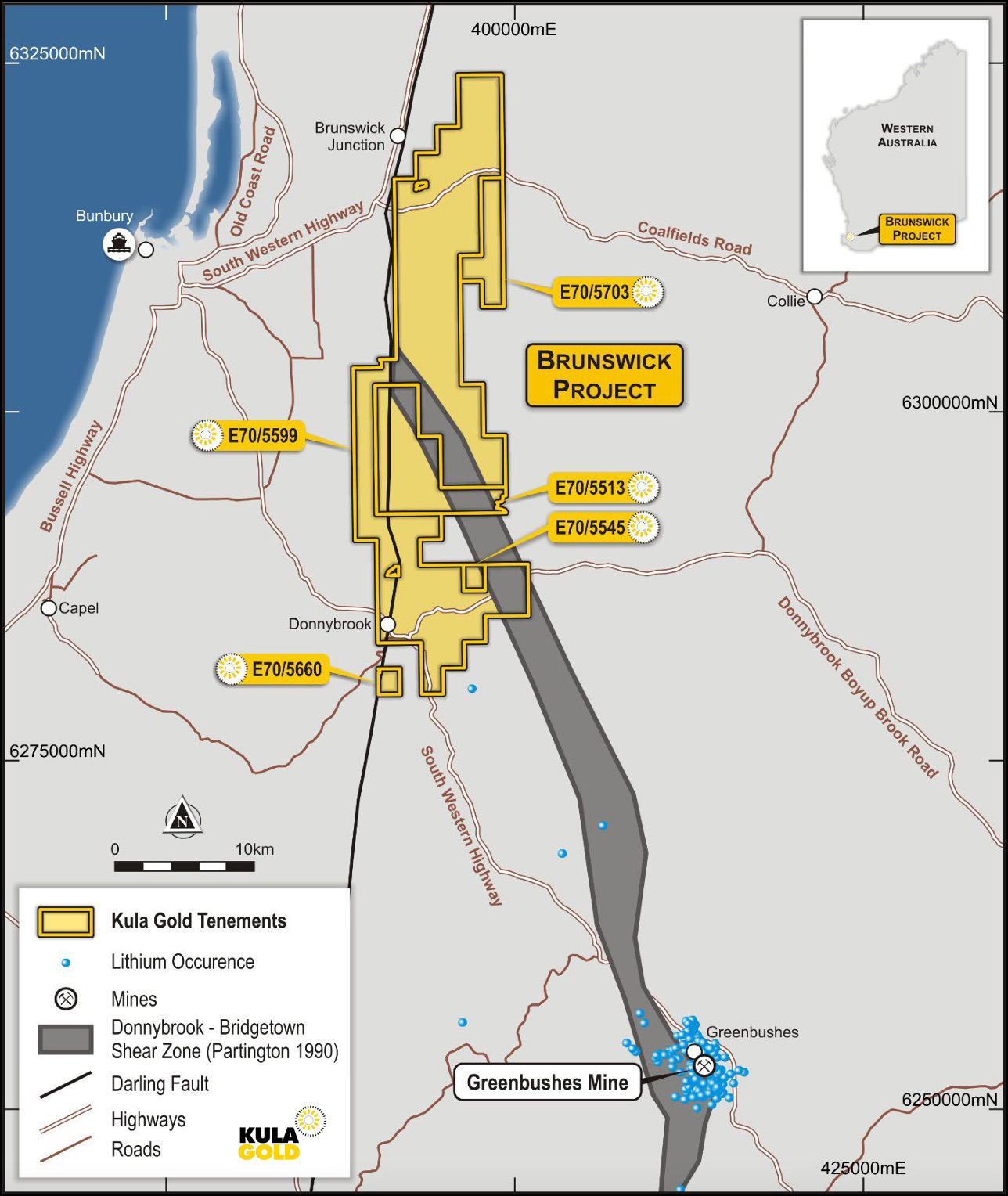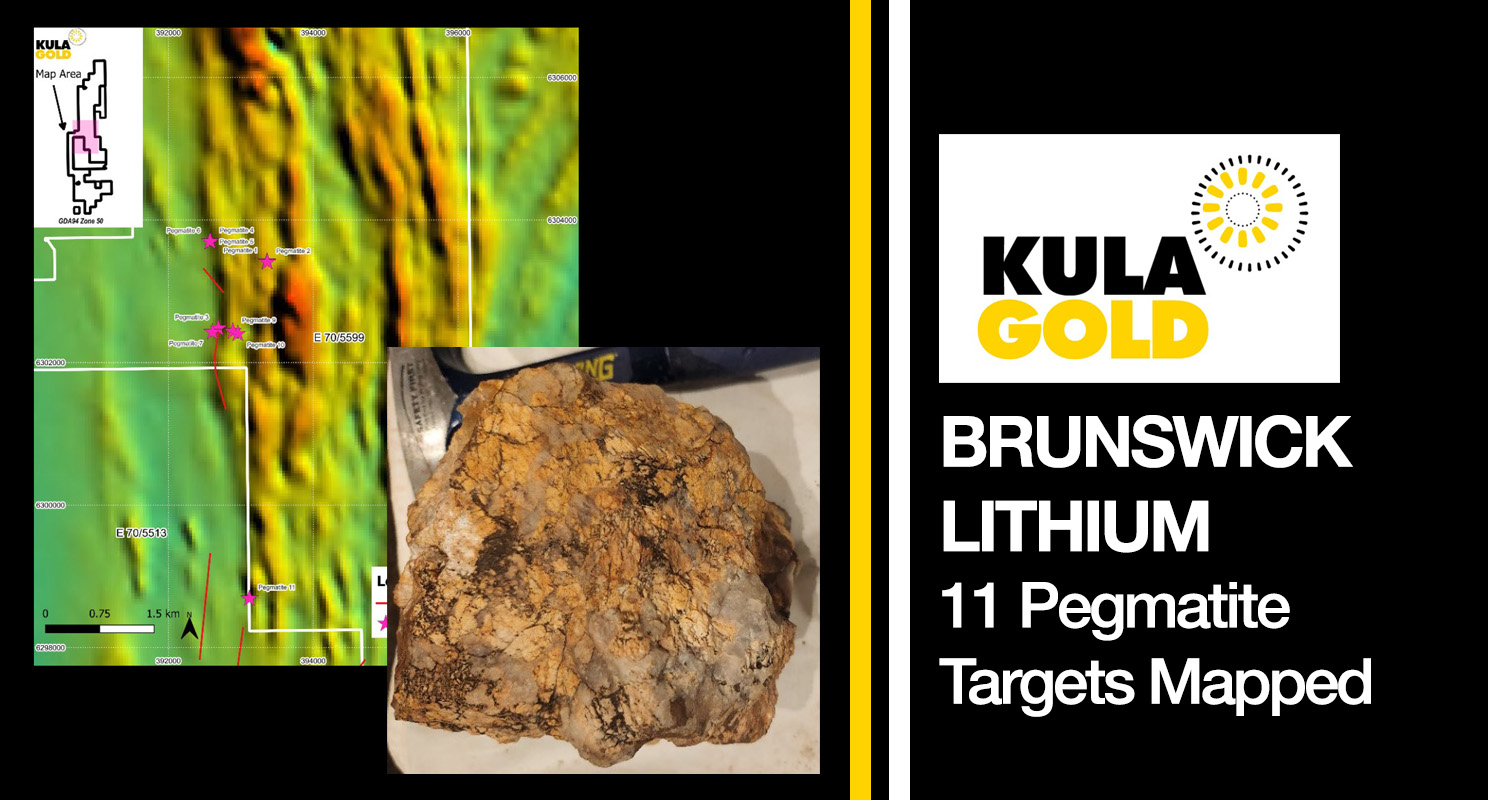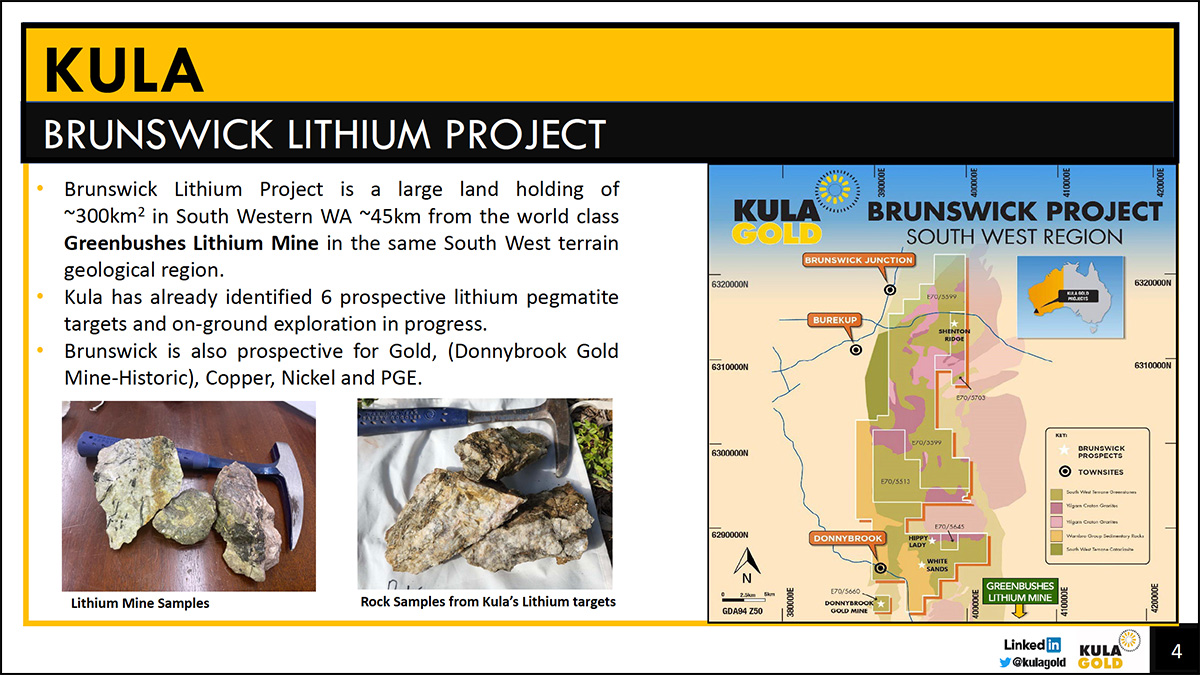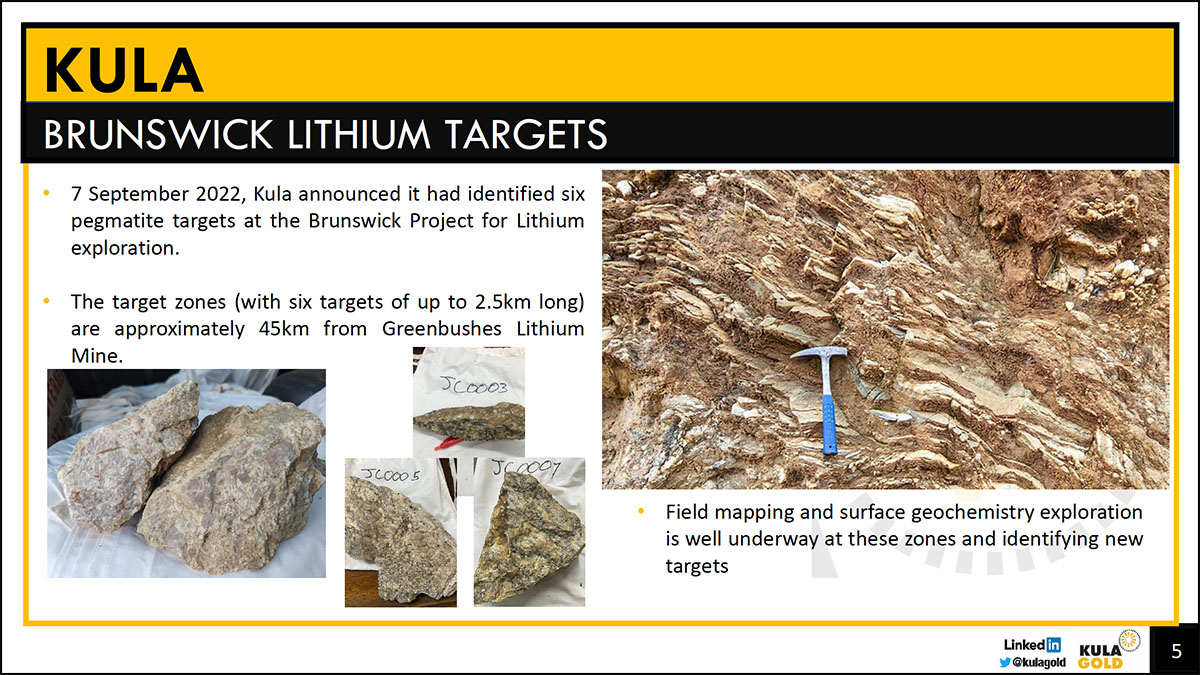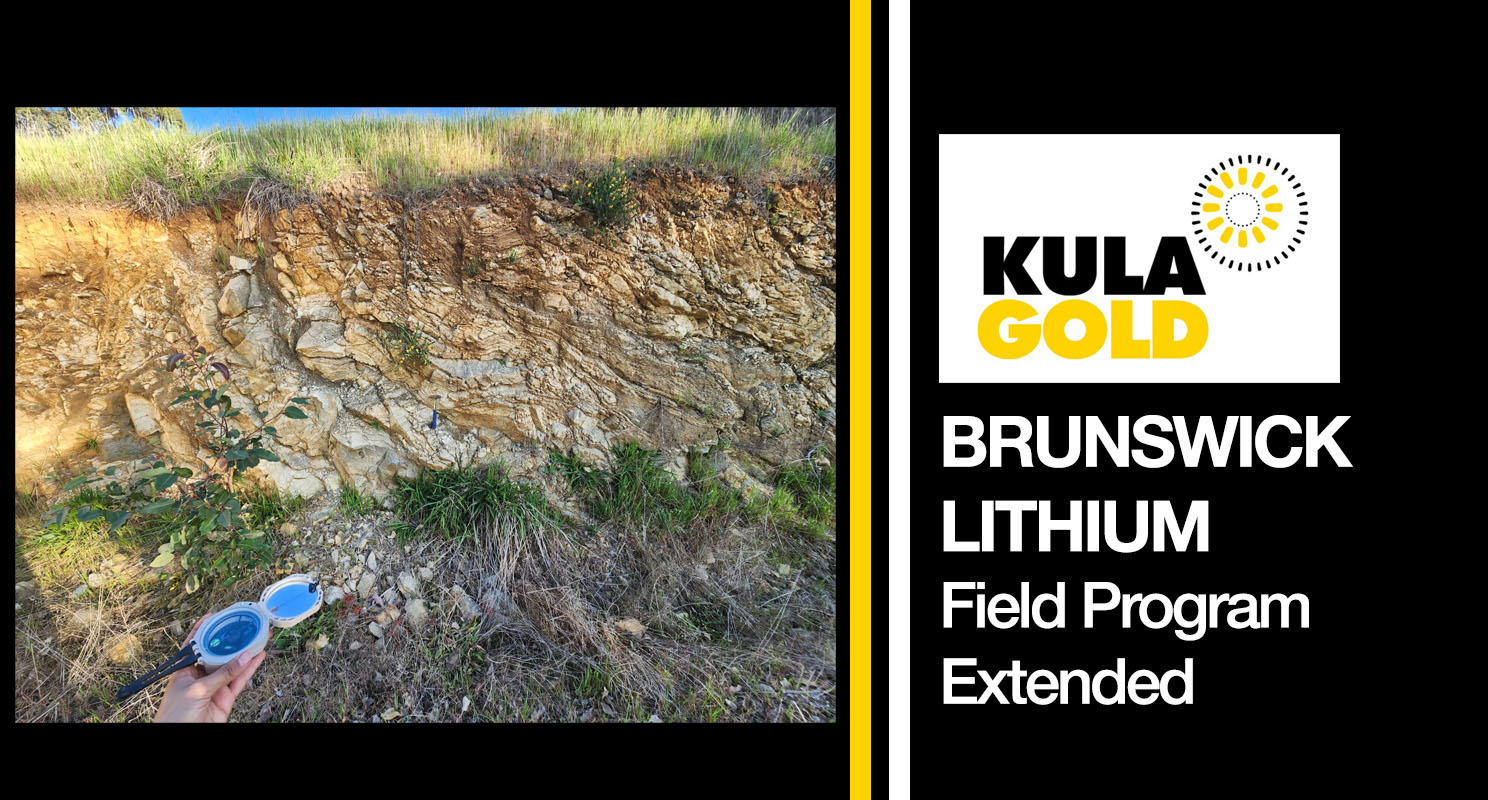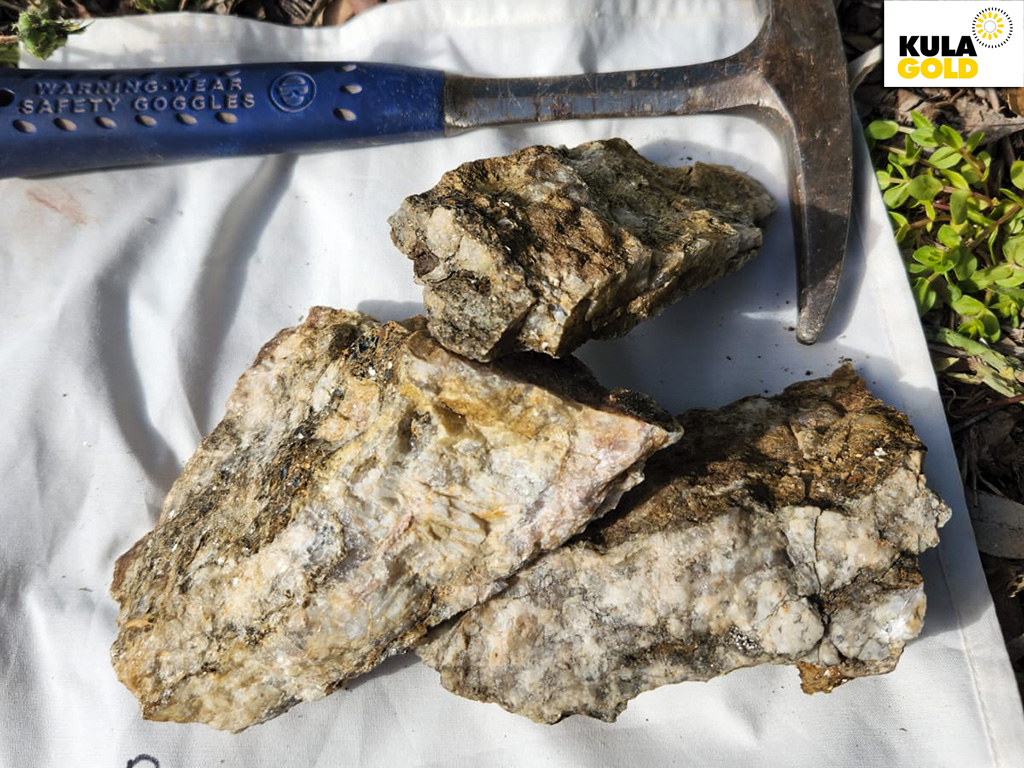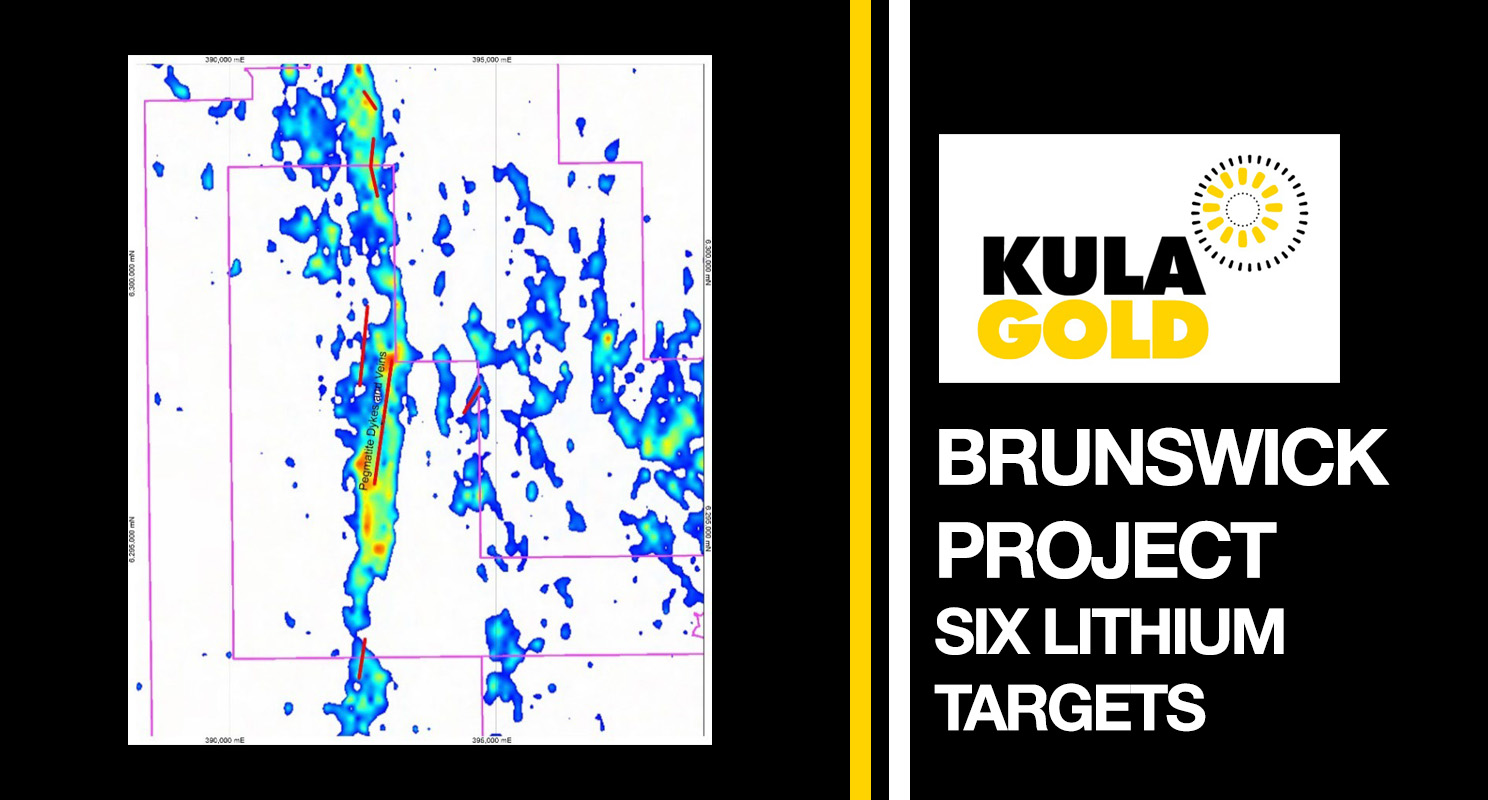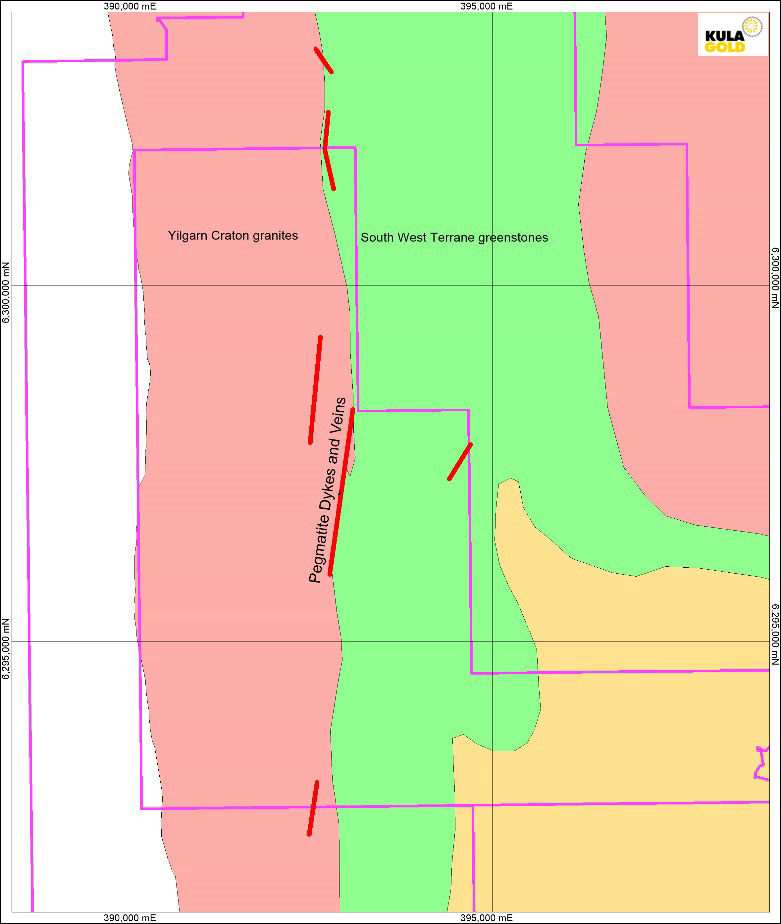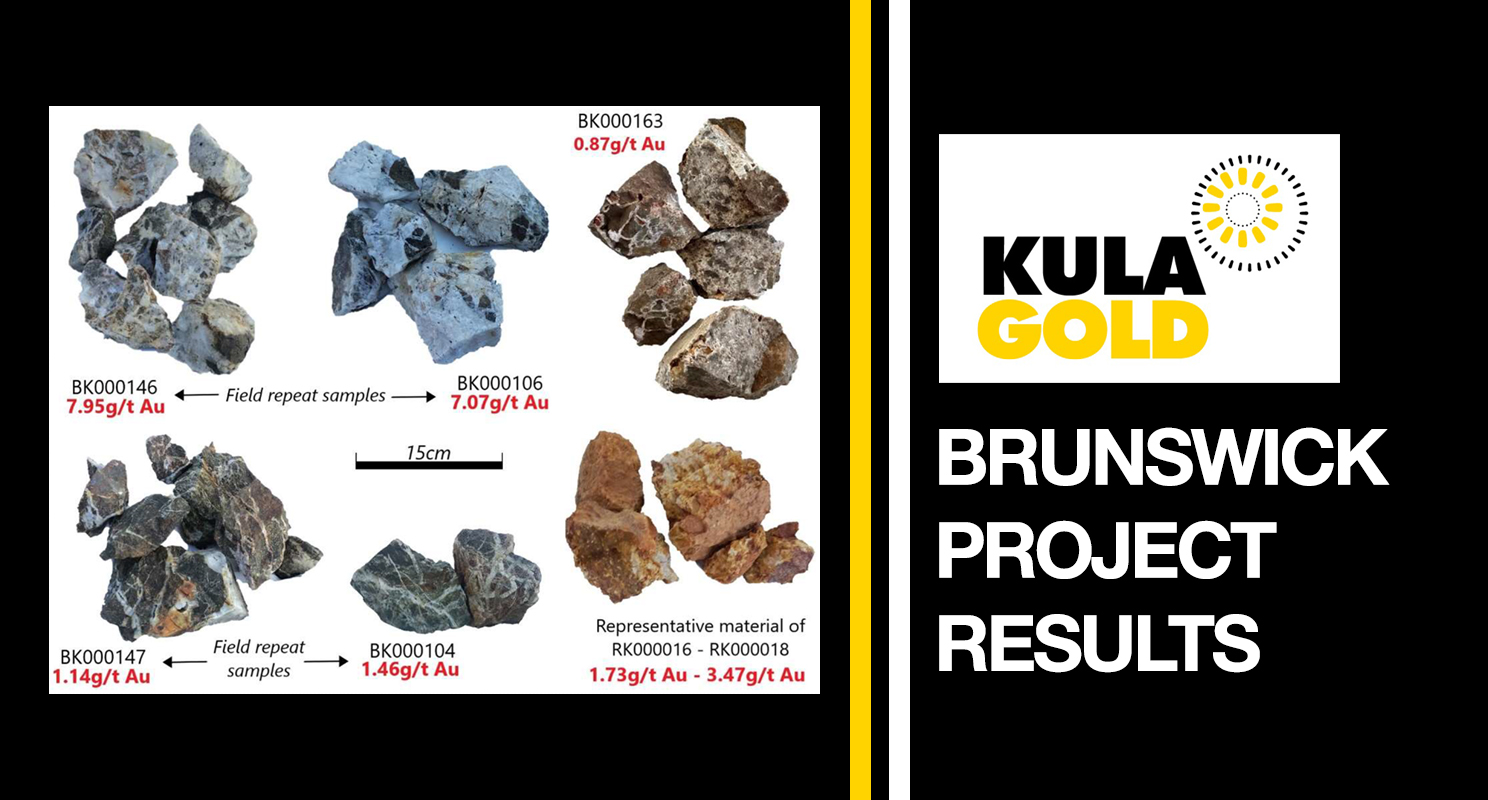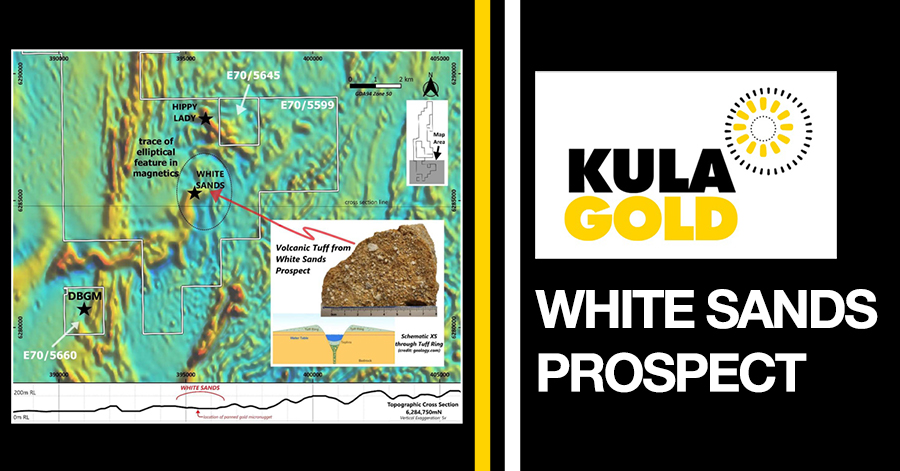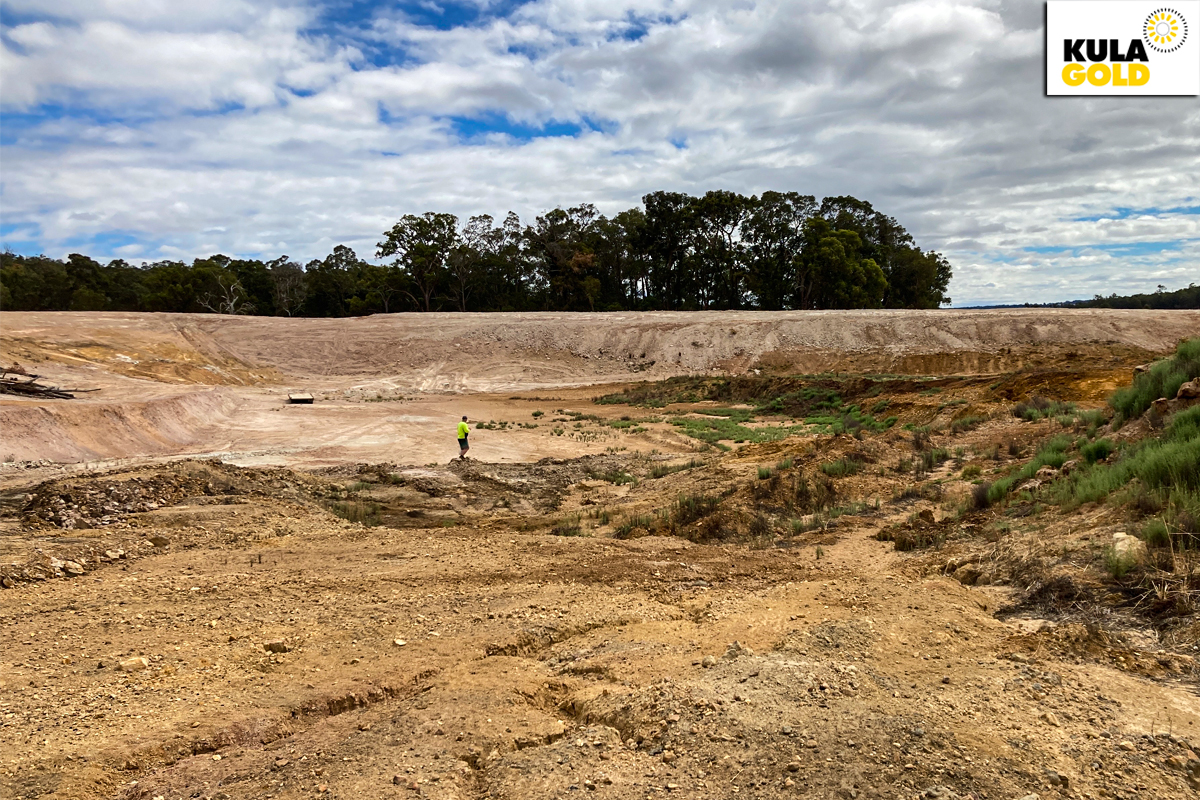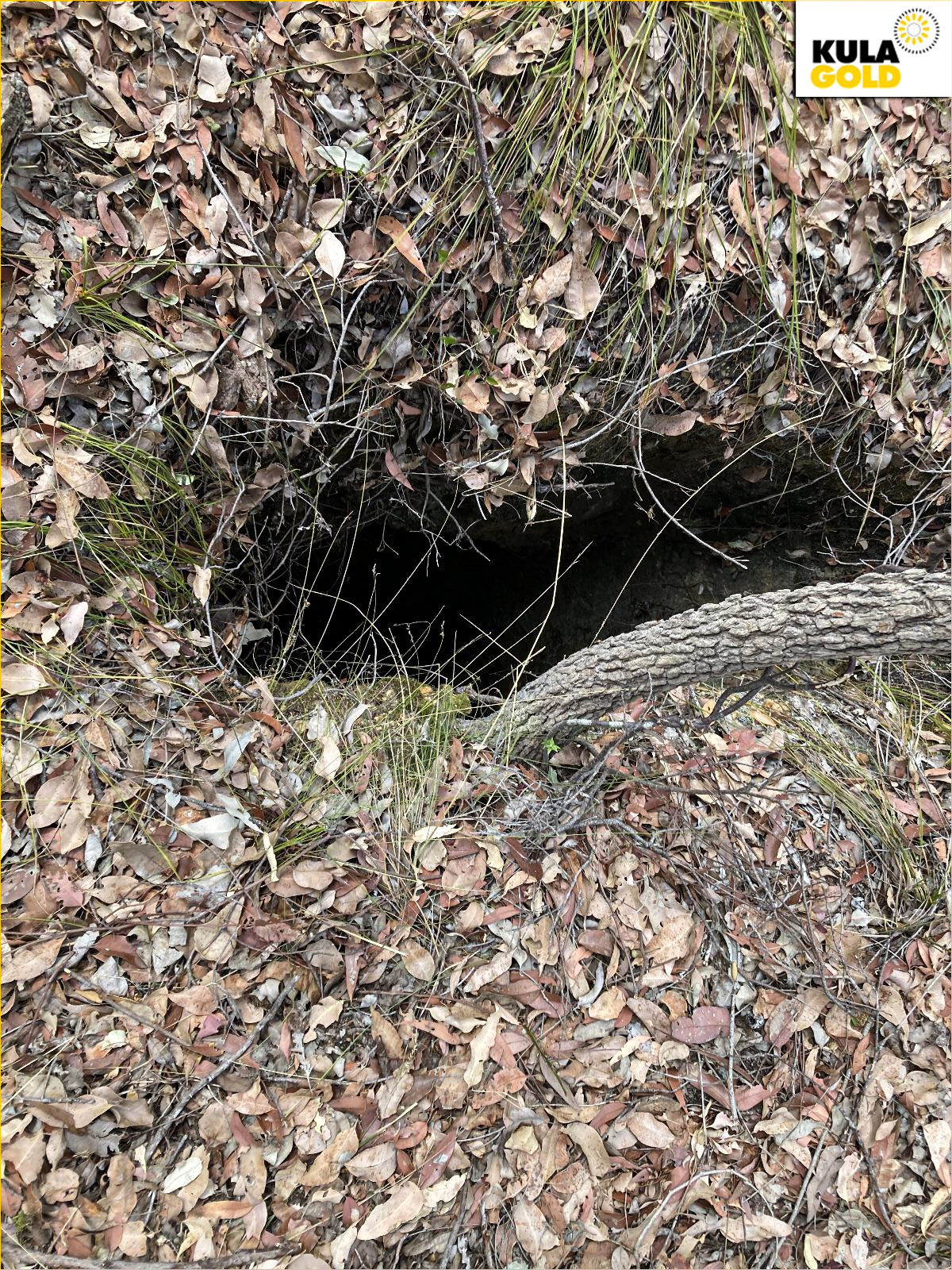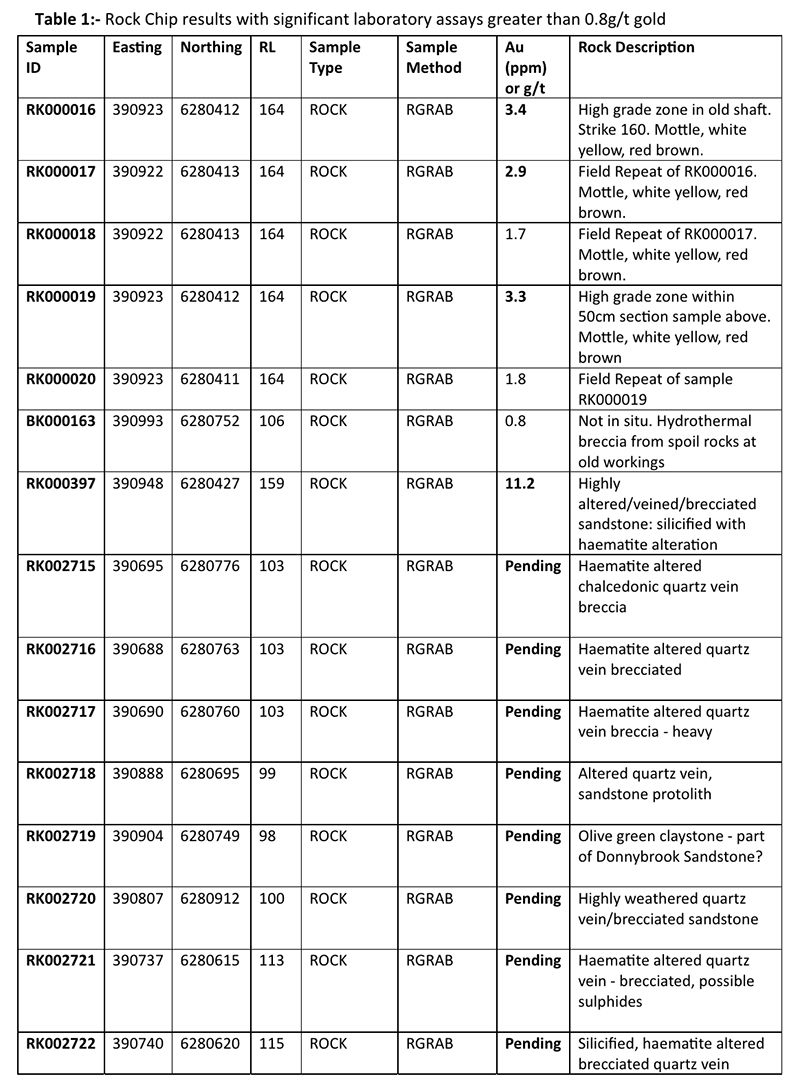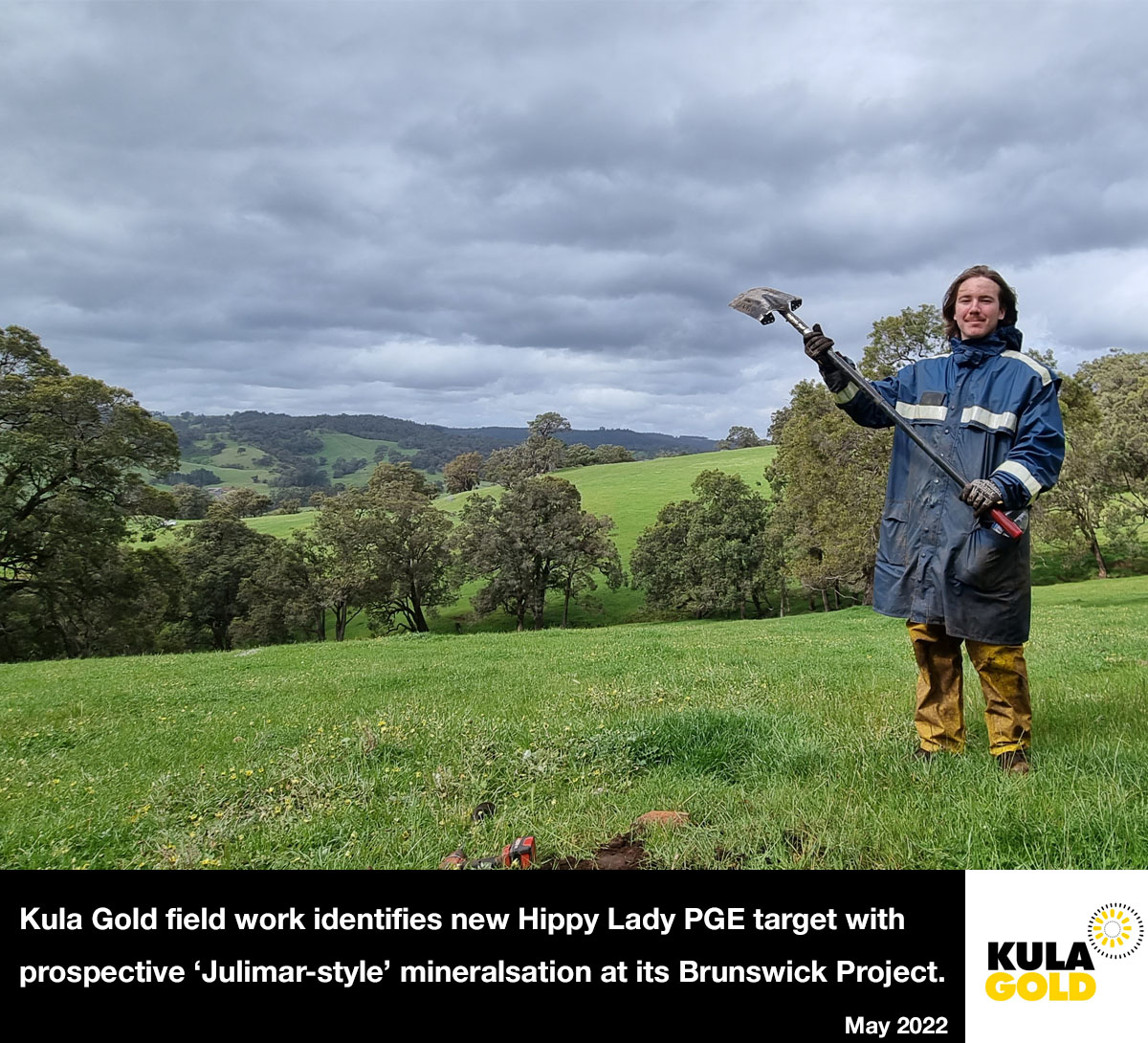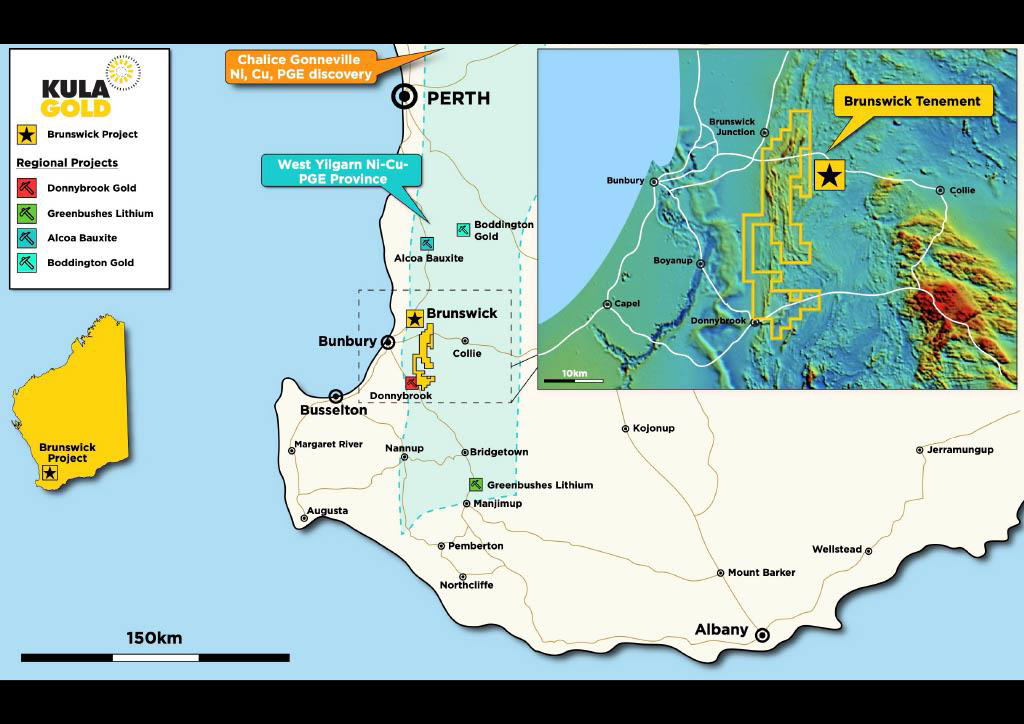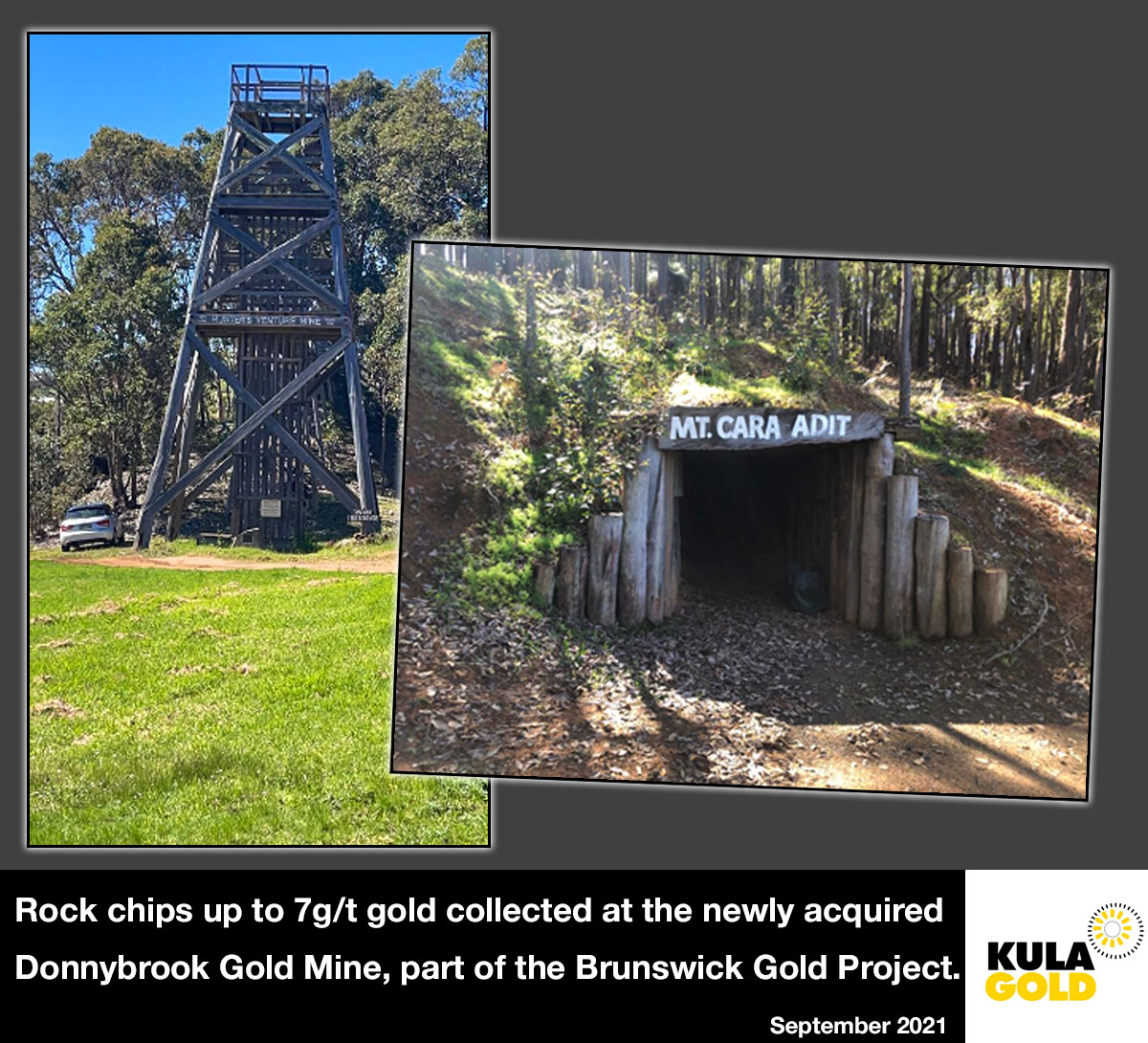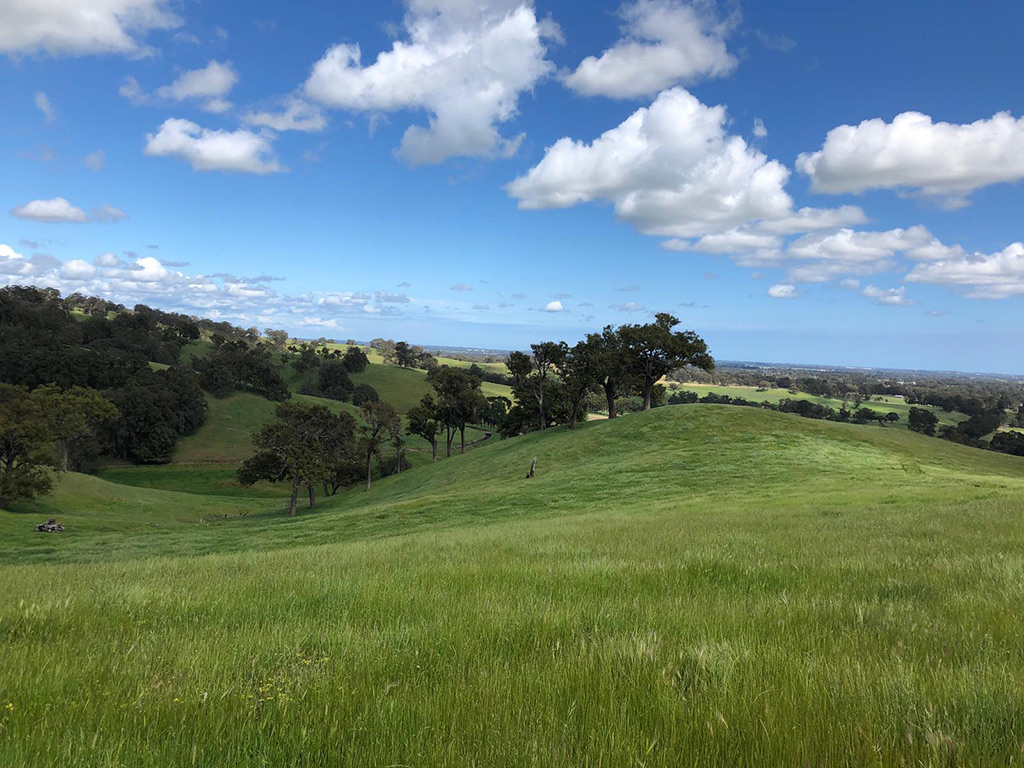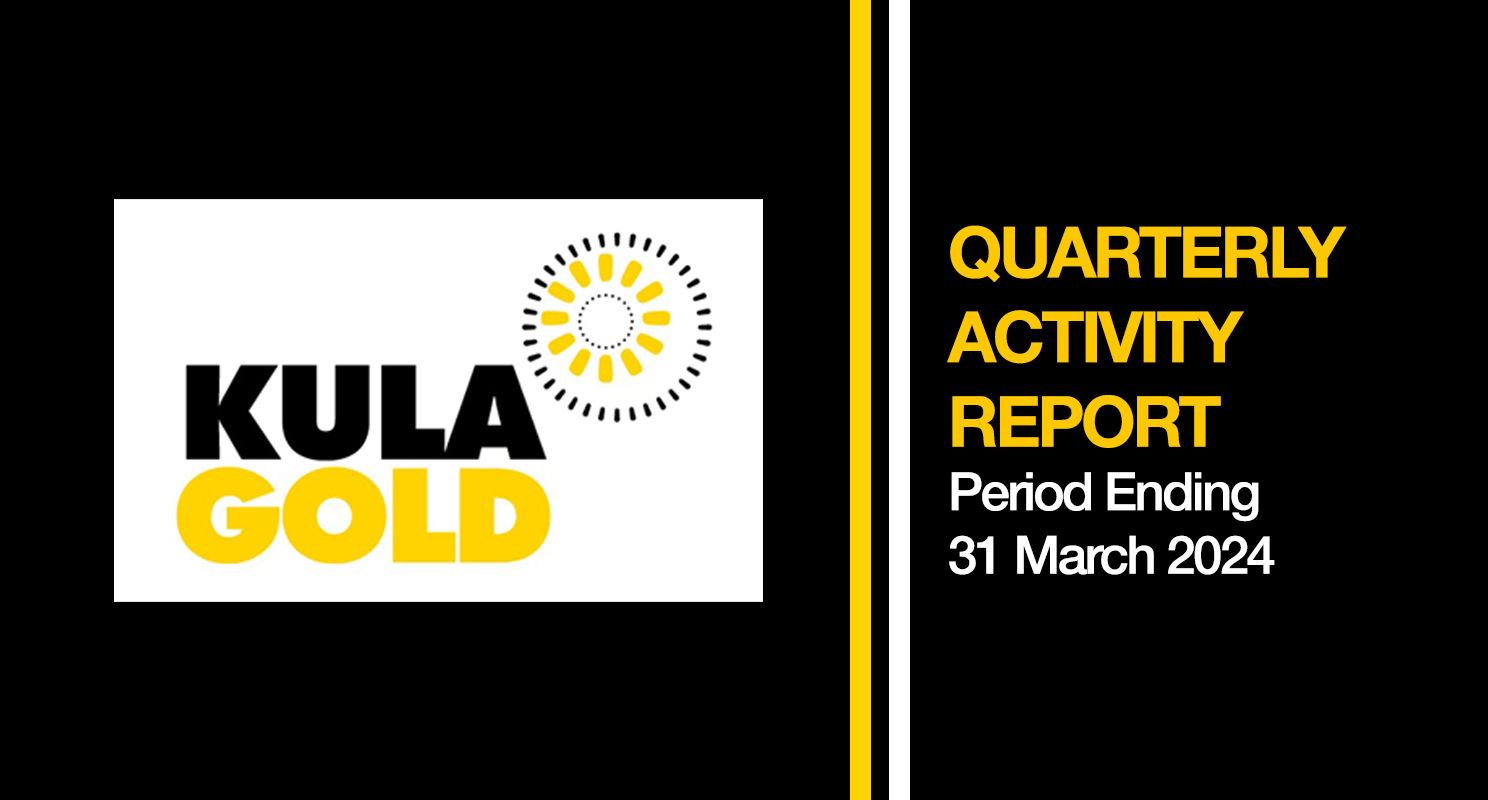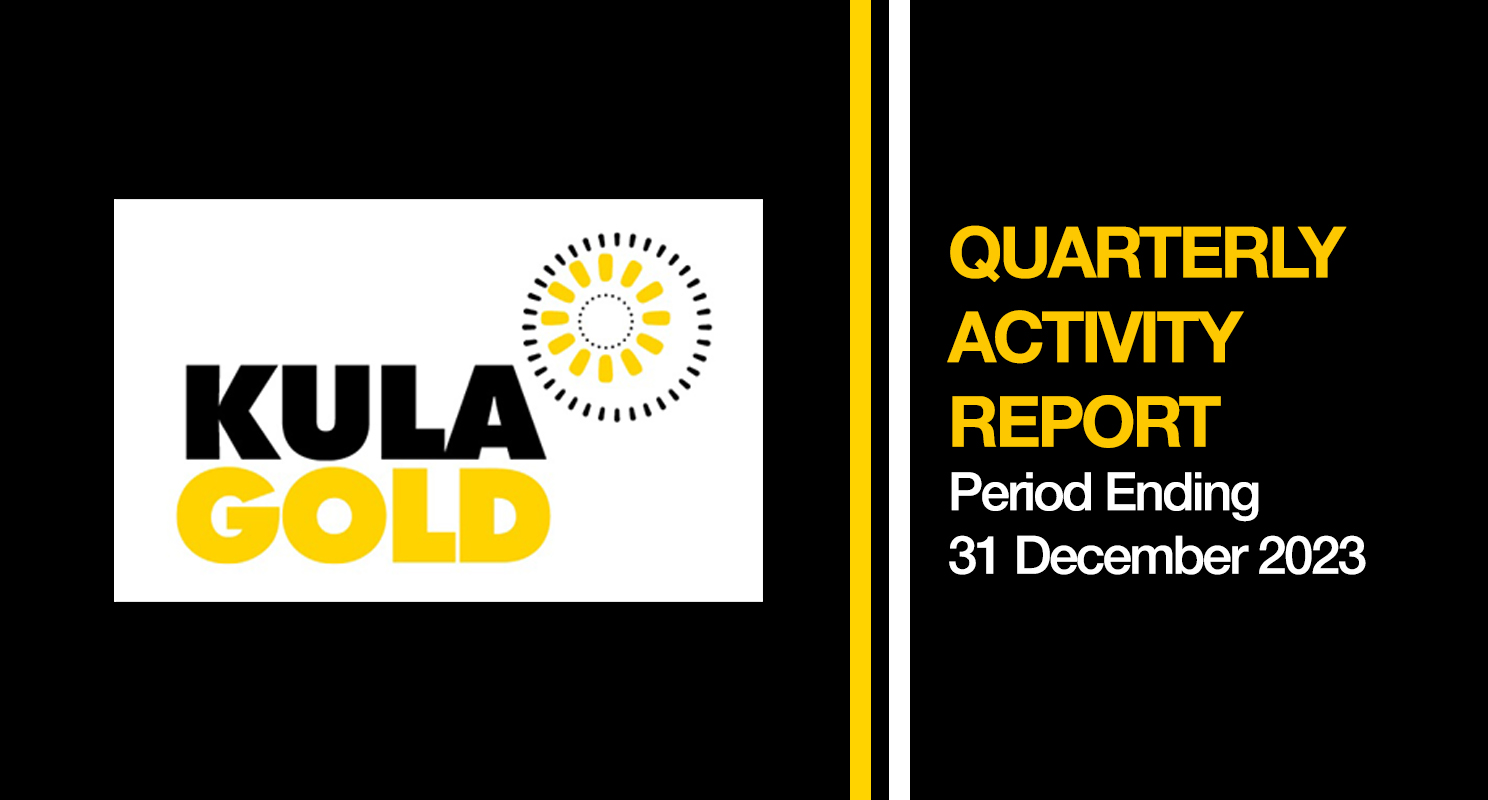

The Brunswick Lithium Project (ELA70/5513 5545 5599 5660 5703) covers ~300km2 and is located between the towns of Donnybrook and Brunswick Junction, approx. 150km south of Perth, Western Australia.
The licence is located in the highly prospective Western Gneiss Terrain which hosts Chalice Gold Mines, Julimar Ni-Cu-PGE Project to the North, and the world’s largest Lithium Mine, Greenbushes, to the south east.
The Brunswick Project has a number of key Prospects:
- Cammilleri and Jarvis Gold Prospects
- Donnybrook Gold Mine (DBGM) Prospect)
- Hippy Lady Prospect
Kula’s Cammilleri Prospect has substantial Gold prospectivity as Kula’s exploration activity ramps up.

Figure 2: Kula Gold’s Brunswick Project, locations of the historic Cammilleri Mine, Mt Cara Mine and Donnybrook.
Kula also has the Kirup Lithium Project located south of Brunswick, and just 25km west of Greenbushes.
2024 Exploration advancements at Brunswick
⛏️ In May 2024, Kula Gold reports that exploration is progressing quickly at the historical Cammilleri/Donnybrook Mine and surrounds.
- Substantial gold prospectivity identified at the historic Cammilleri Mine and surrounds
- Cammilleri Mine recorded past production was extremely rich at 146g/t gold
- 2005 historical RC holes DBRC06, DBRC07 and DBRC08 are in the process of being rebagged, relogged and reassayed with fire assay methodology
- Visible gold panned onsite in some selective haematitic altered quartz rich zones
⛏️ In April 2024, Kula Gold reports results of a recent rock chipping and mapping programme in the vicinity of the historical Camilleri/Donnybrook Mine with an assay result of up to 11.19 g/t Gold.
The Company has done more intensive mapping of the outcropping veins that have haematite alternation and results are at the laboratory pending assay.
Kula Gold’s Managing Director Ric Dawson comments:
“Kula Gold is particularly interested in the Camilleri Prospect in a historically rich area that had gold production of 236.7 ounces from 53 tons of material, (equates to 146g/t). This neglected area had previous miners plan drill holes which for unknown reasons did not eventuate.
Hopefully for Kula Gold’s benefit this historical oversight will be fortuitous.
In addition, the Jarvis Prospect nearby provides excellent gold potential due to identification of unrecorded historic shafts and high order soil anomalies.”
⛏️ Camilleri Prospect
The Camilleri Prospect covers the historical Camilleri and Blackwood Venture gold producers of 236.73 ounces, and 24.0 ounces respectively. The Company has received laboratory results of up to 11.19g/t gold from a recent chip and mapping programme.
This together with the previous Kula Gold rock chips in the near vicinity with grades of 0.8 – 3.3g/t gold is highly encouraging for a more advanced exploration programme in the coming quarters. The Company has an existing Landowner Agreement and has submitted a Programme of Work to facilitate the above.
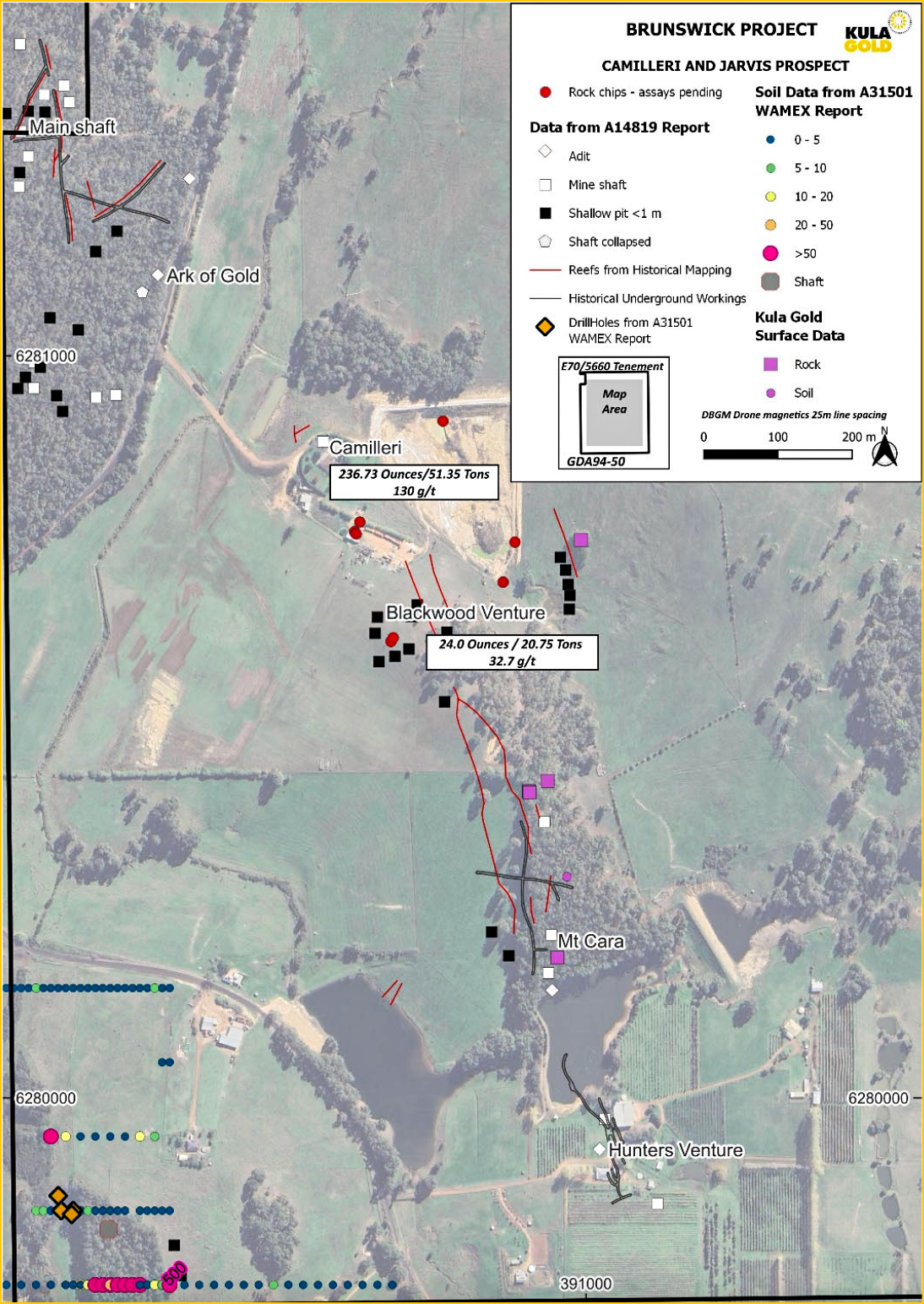
Figure 1. Kula Gold’s Brunswick Project, locations of the Camilleri and Jarvis Prospects near the historic Mt Cara and Hunter Venture Mines, Donnybrook.
2022-2023 Exploration advancements at Brunswick
⛏️ In June 2023, Kula Gold CEO Ric Dawson joined Stockhead’s Explorers Podcast host Barry FitzGerald to talk about the Company’s Lithium hunt in Western Australia near Brunswick/Kirup and Southern Cross, and the range of Projects in the Company’s portfolio.
- Listen to the Podcast with Kula’s CEO below.
⛏️ May 2023 – ASX Release
- Kula Gold Limited reports reconnaissance drilling has commenced at the DBGM Prospect at its 100% owned Brunswick Project.
- Reconnaissance RC drilling is testing structural gold targets and lithium targets from surface pegmatites.
- Airborne drone magnetics has defined a structure below a lithium geochemistry anomaly and has generated drill targets coincident with lithium soil anomalies.
- Brunswick Project 35kms from Greenbushes lithium mine, one of the largest hard rock lithium mines in the world.
- Note: This was completed in late May 2023 (RC drilling has concluded with 4 holes for 360 metres being drilled into felsic augen-gneiss, 4m composite samples have been sent for geochemistry analysis to determine the potential LCT and gold mineralisation)
⛏️ March 2023 – ASX Release
- Kula Gold Limited reports drill ready targets for Brunswick Lithium Project + Tantalum rockchips up to 71ppm at Hippy Lady.
- DBGM Prospect now has drill ready targets.
- Two drone magnetics surveys are complete and has enhanced the drill target potential.
- Drill planning for a short, focused scout program.
- Anomalous tantalum (Ta) rock chip results up to 71ppm on Hippy Lady Prospect, potential LCT suite mineralisation.
⛏️ February 2023 – ASX Release
- Kula Gold Limited reports excellent progress on potential lithium bearing pegmatites at the Brunswick Lithium Project.
- Donnybrook Gold Mine Prospect – Lithium soil anomaly extended to 1.7km.
- A drone magnetics survey is due to commence to further refine drill targets.
- Drill planning for a short, focused scout program.
- First highly anomalous tantalum (Ta) rock chip results to 46ppm on new Hippy Lady East Target, extending past soil geochemistry anomalous results, Ta is one element of LCT (lithium caesium tantalum) mineralisation.
⛏️ November 2022 – ASX Release
- Kula Gold Limited announces a large ~2km x 300m Pegmatite has been mapped at Brunswick Lithium Project.
- PT1 target a large ~2km long and up to 300m wide pegmatite mapped
- PT1 pegmatite located on the Donnybrook-Bridgeton shear zone that hosts the Greenbushes Lithium Mine
- Anomalous lithium in soil sampling from the DBGM Prospect – advancing target
- Kula also continues to progress discussions to secure new opportunities in the lithium sector that would complement the existing Brunswick Project
Published articles in 1990 shows that the Donnybrook-Bridgetown Shear Zone (DBSZ) runs through Kula’s Brunswick Project (Fig 1).
⛏️ October 2022 – ASX Release
- Kula Gold Limited announces that its Lithium exploration at the Brunswick Project has now identified eleven potential lithium bearing pegmatite targets.
⛏️ October 2022 – ASX Release
- Kula Gold Limited announces its Lithium exploration at its Brunswick Project (~45m from Greenbushes Lithium Mine) is progressing ahead of expectations. The exploration on ground is showing extensive prospective areas and as a result the scheduled program is being extended to ensure that as many as possible are systematically mapped and sampled.
⛏️ September 2022 – ASX Release
- Kula Gold Limited announced recent studies have identified six pegmatite target zones in the Brunswick Project near Donnybrook for lithium exploration, approximately 45km from the Greenbushes Lithium Mine. Next stage exploration sampling work on the first target sites to be expedited.
⛏️ July 2022 – ASX Release
- Kula Gold Limited announces results from ongoing exploration activities at the Donnybrook Gold Mine Prospect within their 100% owned Brunswick Project in the southwest region of Western Australia.
-
- Rock samples up to 7.95g/t Gold at the Donnybrook Gold Mine Prospect.
- Soil samples up to 176ppb Gold, in ~250m wide, NNW- trending zone striking over 650m and open.
- 2 gold micro nuggets panned from nearby new White Sands Prospect.
⛏️ July 2022 – ASX Release
- Kula Gold Limited announces the identification of the White Sands Prospect within their 100% owned Brunswick Project in the southwest region of Western Australia.
More on the White Sands Prospect below.
⛏️ May 2022 – ASX Release
- Kula Gold Limited announced a significant advancement with the new Hippy Lady Prospect identified at the Brunswick Project.
Soil sampling has identified a new area of interest, the Hippy Lady Prospect, which is prospective for both ‘Julimar-style’ Pt-Pd-Au±Cu mineralisation as well as Archean greenstone-hosted gold mineralisation.
Kula Gold’s Brunswick Project was staked on the concept the PGE system – discovered by Chalice Mining at Julimar – may extend this far south.
The Hippy Lady PGE Prospect is an early potential validation of this concept – more on the Hippy Lady Prospect below.
⛏️ April 2022 – ASX Release
- Kula Gold Limited announces EM surveying is underway at Brunswick Ni-PGE Li Project in WA.
CAMILLERI & JARVIS GOLD PROSPECTS
⛏️ In April 2024, Kula Gold reported results of a recent rock chipping and mapping programme in the vicinity of the historical Camilleri/Donnybrook Mine with an assay result of up to 11.19 g/t Gold.
- Focused gold exploration in early 2024 has yielded highly prospective gold mineralisation in the wholly owned Brunswick Project.
- Substantial gold prospectivity identified at the historic Camilleri Mine and Jarvis Prospects near the historic Mt Cara and Hunter Venture Gold Mines with assays to 11.19 g/t gold where past production was extremely rich at 146 g/t gold.
⛏️ Camilleri Prospect
The Camilleri Prospect covers the historical Camilleri and Blackwood Venture gold producers of 236.73 ounces, and 24.0 ounces respectively. The Company has received laboratory results of up to 11.19g/t gold from a recent chip and mapping programme.
This together with the previous Kula Gold rock chips in the near vicinity with grades of 0.8 – 3.3g/t gold (Table 1) is highly encouraging for a more advanced exploration programme in the coming quarters. The Company has an existing Landowner Agreement and has submitted a Programme of Work to facilitate the above.
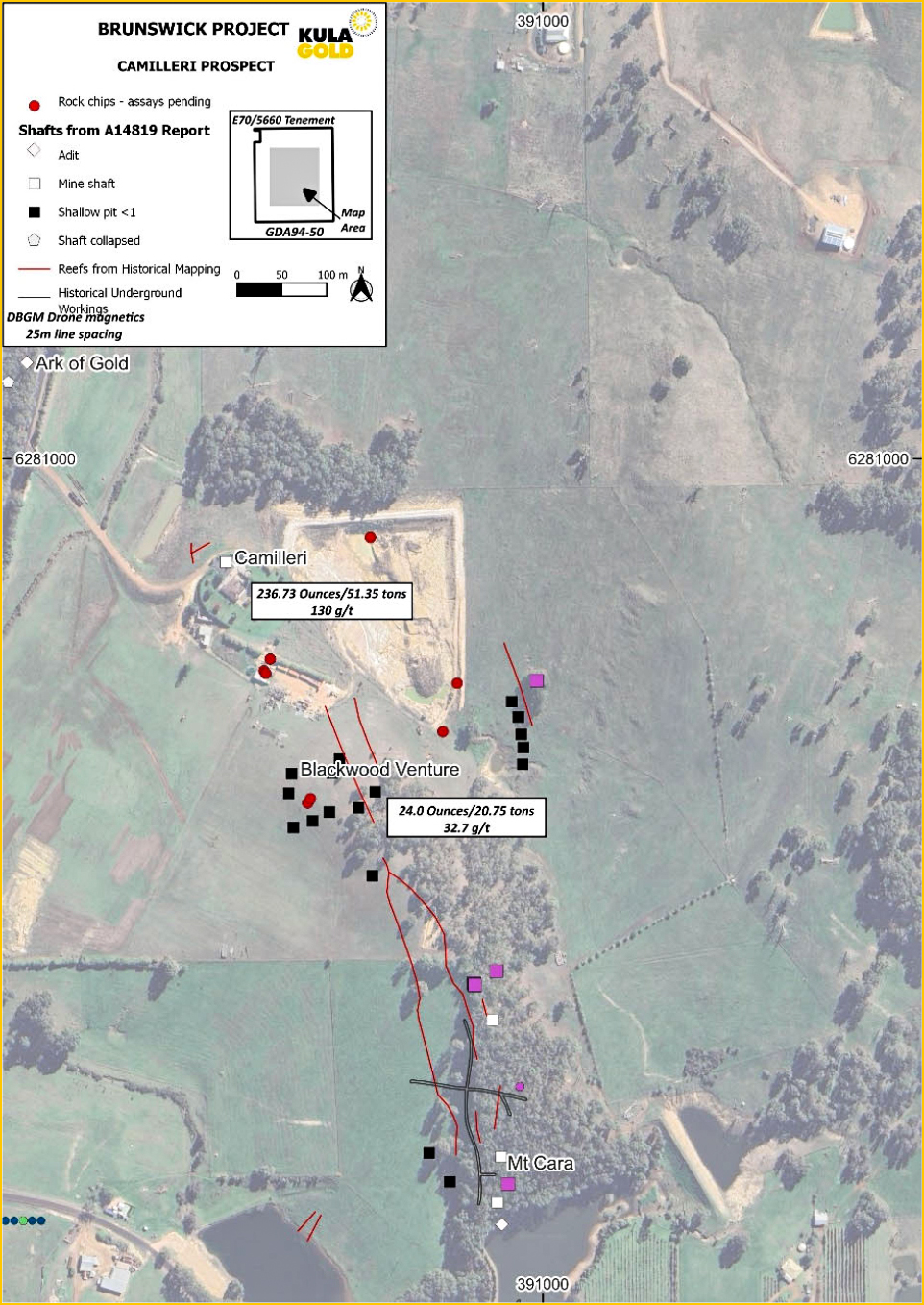
Figure 3: Location of the Camilleri Prospect and the Camilleri and Blackwood Venture gold production.
The Camilleri Prospect is in the regional setting of the Donnybrook Gold Mine (DBGM) and is in a gold trend that is located near the intersection of the major Donnybrook Shear Zone and the Darling Fault Zone and sits along/adjacent to this main gold corridor.
Below, Figure 4, shows haematitic altered quartz vein in a host sandstone.
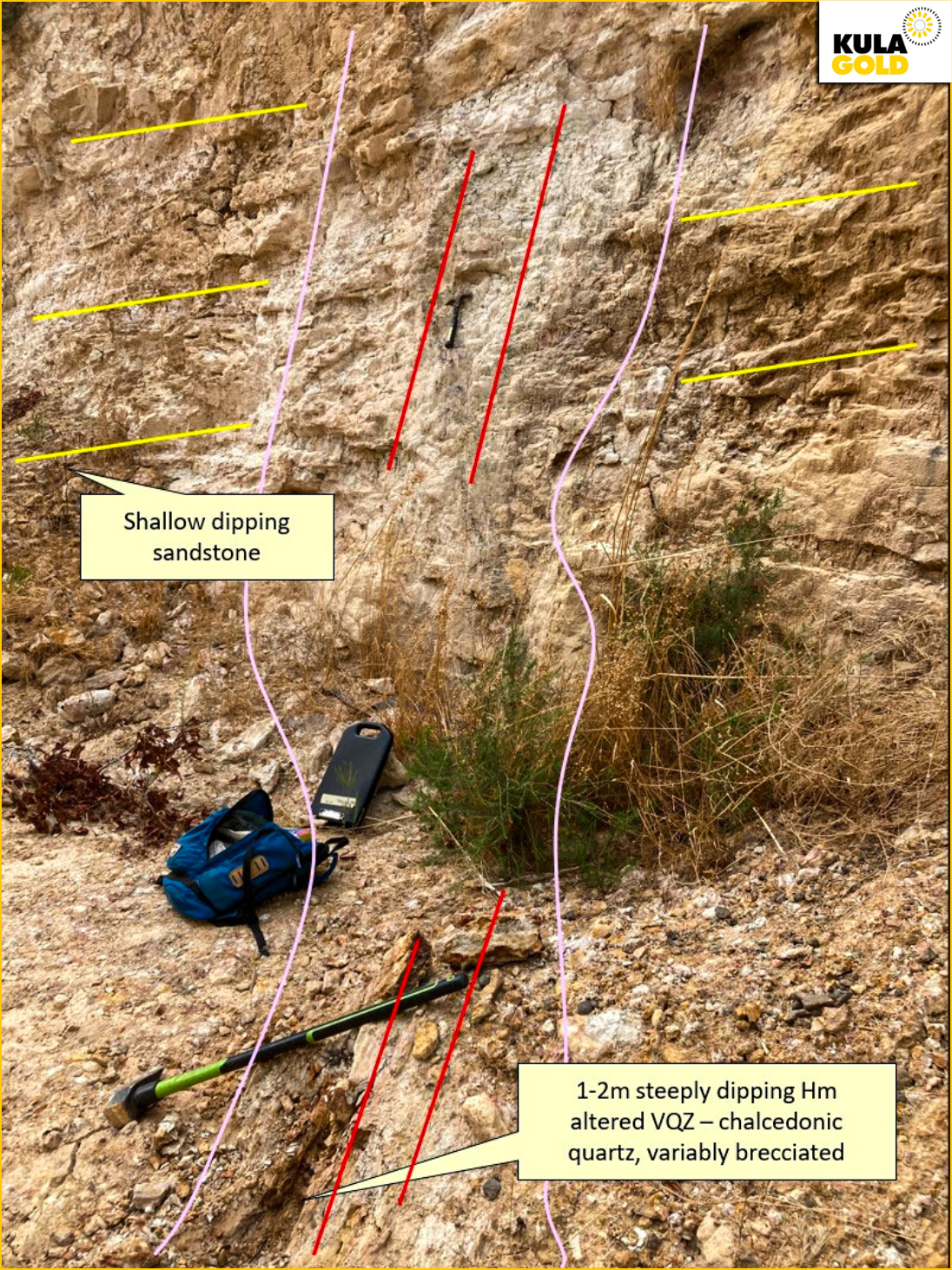
Figure 4: Outcropping predominantly hematite altered chalcedonic quartz veins within shallowly dipping sandstones. No visual sulphides are evident.
⛏️ Jarvis Prospect
The gold prospectivity of the Jarvis Prospect was identified following a recent geological review of ex-Metana Minerals NL soil sampling and drilling during the mid-1980’s, see Figure 2.
The Jarvis Prospect was scout drilled in the 1980’s following up a peak 500ppm soil anomaly with 4 percussion drill holes that used inferior equipment which resulted in poor and contaminated sample recovery.
Kula Gold has a mapping, rock chipping and UFF soil sample programme underway this quarter to provide a better gold definition for advanced
exploration.
Further fieldwork on this epithermal style gold target is in progress.
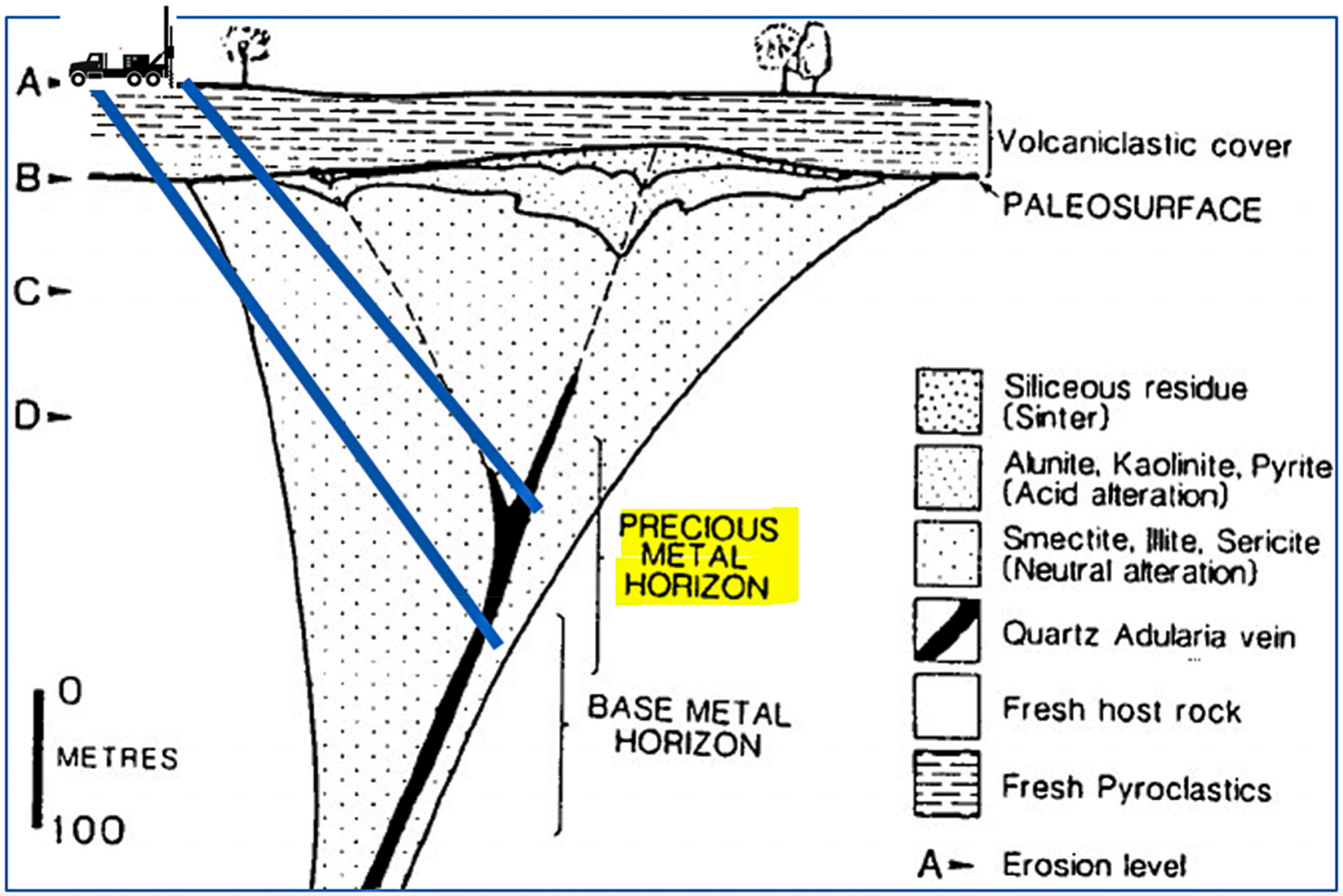
Figure 6: An idealised model for epithermal gold deposits (Irvine and Smith, 1990) showing drill traces and rig. The symbols A, B, C and D denote hypothetical levels of exhumation of the deposit by surface erosion.
*Visual estimates of mineral abundance should never be considered a proxy or substitute for laboratory analysis where concentrations or grade are the factor of principal economic interest. Visual estimates also potentially provide no information regarding impurities or deleterious physical properties relevant to valuations.
⛏️ In May 2022, Kula Gold announced soil sampling has identified a new area of interest, the Hippy Lady Prospect, which is prospective for both ‘Julimar-style’ Pt-Pd-Au±Cu mineralisation as well as Archean greenstone-hosted gold mineralisation.
Kula Gold’s Brunswick Project was staked on the concept the PGE system – discovered by Chalice Mining at Julimar – may extend this far south. The Hippy Lady PGE Prospect is an early potential validation of this concept.
⛏️ In July 2022 – Kula Gold announced the identification of the White Sands Prospect within the Brunswick Project in Western Australia.
Reconnaissance work identified quartz rich, volcanic tuff (see inset photo Figure 6) at the White Sands Prospect, which provides evidence of explosive volcanism within the region. The topographic cross section indicates that White Sands sits within a slight depression, surrounded by slight topographic highs where volcanic tuff has been observed. A subtle ellipsoidal ring (indicated in Figure 6), which appears coincident with the subtle topographic highs, can be seen in the magnetics surrounding the White Sands Prospect—it is possible that this feature represents a remnant tuff ring (refer Figure 6 inset image).
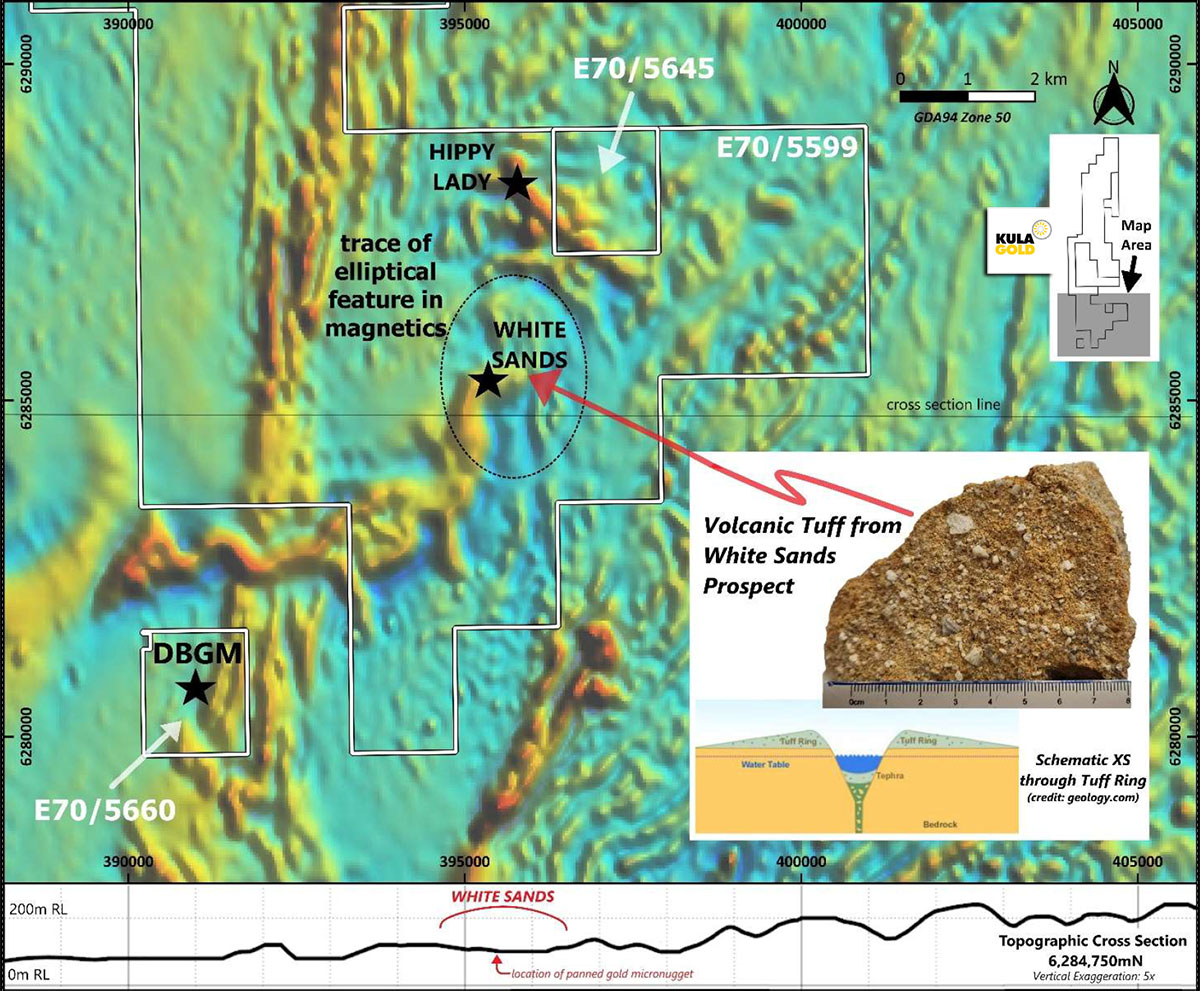
Figure 6: Location of White Sands, DBGM & Hippy Lady Prospects overlain on regional magnetics (TMI RTP over TMI-RTP-1VD shown). Magnetics sourced from Collie SI5006 Survey. Inset image showing Volcanic Tuff obtained from White Sands Prospect and a schematic cross section through an idealised tuff ring. Topographic cross section showing location where gold micro nuggets were panned.
Further work, including mapping the tuff extents and 3D inversion modelling of the publicly available magnetic data may provide evidence to substantiate this theory. Given that White Sands is situated only 6km northeast of DBGM, Kula geologists are investigating if the volcanism at White Sands may have been the geological driver for the Donnybrook epithermal system.
In areas previously quarried for silica sands, the surface has been mined back to expose saprolitic volcanic tuff, with channels and valleys cut through over time by creeks accommodating surface drainage (Figure 7A).
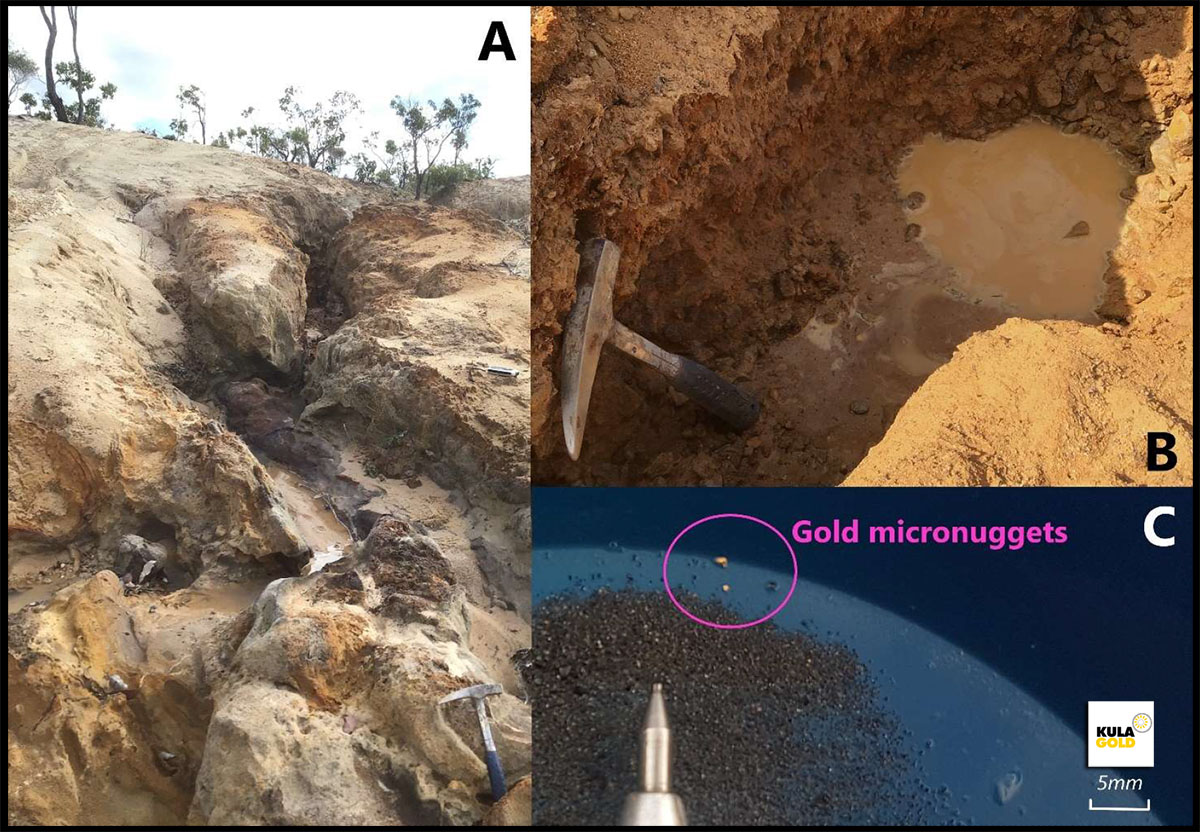
Figure 7. Photographs from the White Sands Prospect. Showing A: creek channels cut into the exposed saprolitic volcanic tuff (geopick for scale) which are typical at the White Sands Prospect. B: Gold panning hole dug in the small delta formed by the creek channels at the small dam (geopick for scale), and C: gold micro nuggets panned at White Sands Prospect.
Two gold micro nuggets (Figure 7C) were panned by a Kula geologist and local prospector from hole dug (Figure 7B) within the mouth of a small dam (Panning conducted in a small, seasonal dam located approx. 395625mE, 6284515mN) where the creeks formed a delta. The creeks that flow into the dam originate within White Sands Prospect which means the source of this gold is likely within the prospect area. Auger and/or aircore drilling is being planned to further test the potential for gold anomalism at White Sands.
Kula geologists will continue to work on building the geological observations from White Sands into the local and regional geological interpretation, to help determine if there is a geological link between DBGM and the White Sands volcanism and will use this new information to assist in targeting other areas of potential gold mineralisation for further reconnaissance work.
References: Chalmers, DI (1996). Open File Report A48179: Donnybrook Project, Annual Report for period 16/12/1994 to 15/12/1995, E70/1172. Genesis Resources. NL.
2021 Exploration advancements from the Brunswick Project.
⛏️ September 2021 – Rock chips up to 7g/t gold collected at newly acquired Donnybrook Gold Mine.
⛏️ May 2021 – Brunswick Project area expanded to include historic Donnybrook Gold Mine.
⛏️ February 2021 – Kula Gold Limited released visual results from a rock sampling program reporting visible copper mineralisation.
The assay results from those rock samples showed Cu up to 0.35% as chalcopyrite, confirming the presence of copper-bearing sulphides in the project area.
Fieldwork by the company’s geological team has identified potential for three types of mineralisation and these are now the focus of exploration work:
1. Julimar Style Ni-Cu-PGE mineralisation.
2. Epithermal gold mineralisation– as evidenced by the historic Donnybrook Goldmines Ltd south of the licence with production of 1,100oz from 1,497 tons of ore between 1897 and 1904. (Ref: BHP Minerals Ltd DMIRS report of 1 Feb 1987 for exploration work 1985-87)
3. Archean Cu-Au mineralisation analogous to Newmont’s Boddington Copper-Gold Mine 75km NE which is one of the largest gold mines in the world, producing approximately 700k oz Au and 35kt Cu p.a.
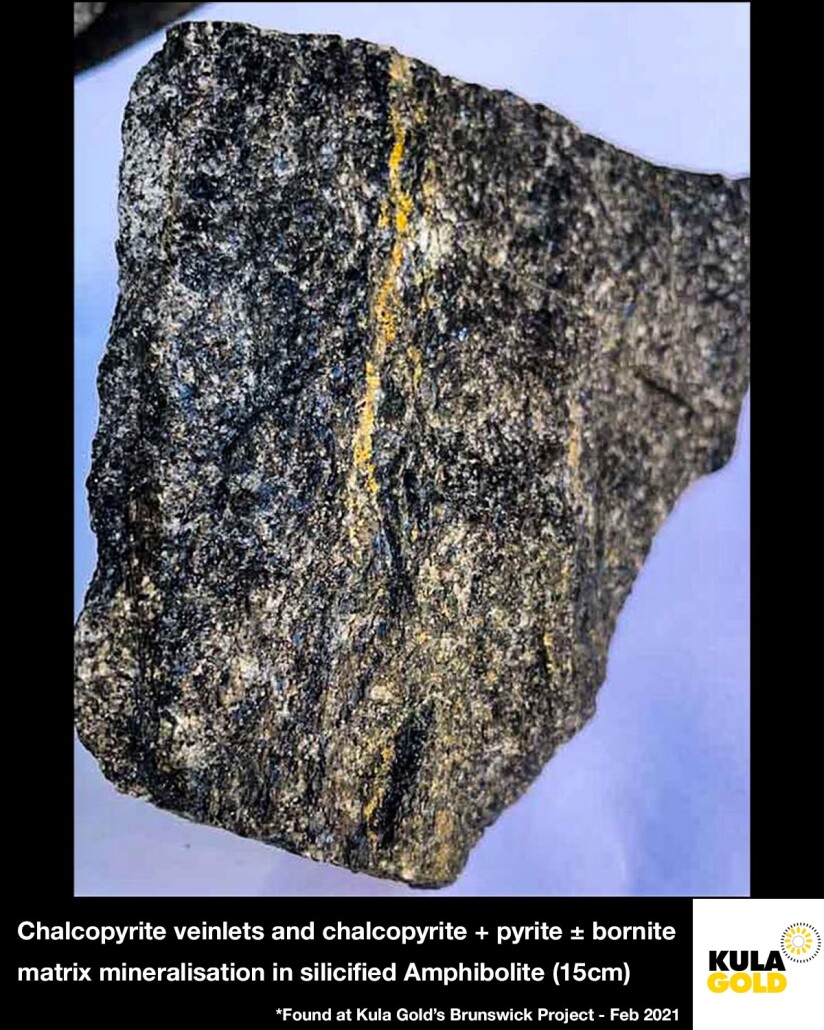
⛏️ Previous Kula studies of the open file magnetic data showed some subdued magnetic highs which Kula considered were worth investigating further to see if the subdued magnetic response was masking potential Ultramafics in the licence area.
The open file magnetics within the licence area were reprocessed to highlight the magnetic highs which will be field checked in the coming weeks to verify the actual rock types. Comparison of the open file and re-processed magnetics are shown in the images below.
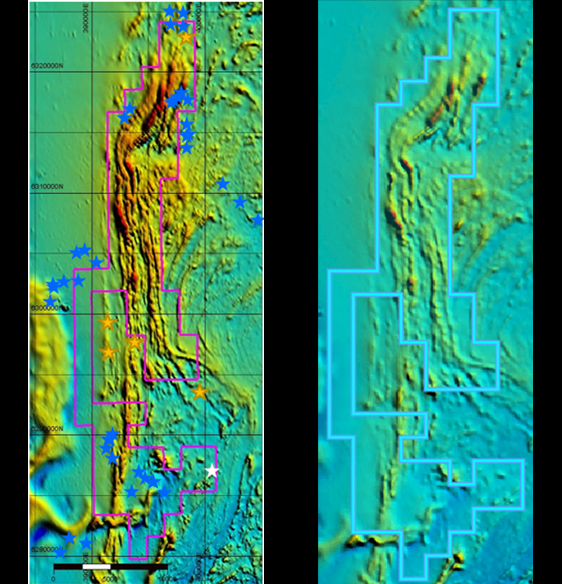
Images showing the comparison between reprocessed magnetics (left) and the open file magnetics (right) with red areas in the reprocessed magnetics interpreted to be potential Ultramafics – subject to field verification. Gold stars show historical gold projects, White stars are known pegmatites, Blue stars are rock/laterite quarries in the area
The licence area also contains an historical gold project east of Brunswick junction known as Brunswick and is also prospective for Lithium bearing pegmatites.
For the latest from the Brunswick Project – refer to the News Releases located on this page.
Quarterly Activity Report: Period Ending 30/06/2024
Kula Gold Limited presents its Quarterly Activity Report for the period ended 30 June 2024. View the PDF version of this ASX Announcement Figure 1: Kula’s Southern Cross Projects (noting the non-Kula projects in green). MT [...]
Brunswick Exploration Update – Substantial Gold prospectivity at Cammilleri Mine & surrounds
Kula Gold Limited reports that exploration is progressing quickly at the historical Cammilleri/Donnybrook Mine and surrounds. Fortunately, most of the old sample bags are onsite and intact which allowed the Company to do extensive relogging and reassaying of the 2003 [...]
Quarterly Activity Report: Period Ending 31/03/2024
Kula Gold Limited presents its Quarterly Activity Report for the period ended 31 March 2024. View the PDF version of this QAR MARVEL LOCH PROJECT - E77/2621 - 100% Owned - KAOLIN & GOLD The Company reported that [...]
Brunswick Exploration Update – Results up to 11.19 g/t Gold at new Camilleri Prospect
⛏️ Kula Gold Limited reports results of a recent rock chipping and mapping programme in the vicinity of the historical Camilleri/Donnybrook Mine with an assay result of up to 11.19 g/t Gold. The Company has done more intensive mapping of [...]
Kirup Exploration Update – Gold prospectivity at Cobra + Mustang
Kula Gold Limited reports the Company has identified substantial epithermal gold prospectivity at both the Cobra and Mustang Prospects during recent drilling within its Kirup Project, with rock chip results to 3.5g/t gold. Kula reports the recent RC drilling [...]
Quarterly Activity Report: Period Ending 31/12/2023
Kula Gold Limited presents its Quarterly Activity Report for the period ended 31 December 2023. View the PDF version of this ASX Announcement Figure 1: Kula’s Kirup & Brunswick Project’s, location of Greenbushes Mine & Albemarle’s Kemerton [...]

